Need a consultation? Call now:
Talk to our experts:
- Business Plan for Investors
- Bank/SBA Business Plan
- Operational/Strategic Planning
- E1 Treaty Trader Visa
- E2 Treaty Investor Visa
- Innovator Founder Visa
- UK Start-Up Visa
- UK Expansion Worker Visa
- Manitoba MPNP Visa
- Start-Up Visa
- Nova Scotia NSNP Visa
- British Columbia BC PNP Visa
- Self-Employed Visa
- OINP Entrepreneur Stream
- LMIA Owner Operator
- ICT Work Permit
- LMIA Mobility Program – C11 Entrepreneur
- USMCA (ex-NAFTA)
- Franchise Business Planning
- Landlord Business Plan
- Nonprofit Start-Up Business Plan
- USDA Business Plan
- Online Boutique
- Mobile Application
- Food Delivery
- Real Estate
- Business Continuity Plan
- Buy Side Due Diligence Services
- ICO whitepaper
- ICO consulting services
- Confidential Information Memorandum
- Private Placement Memorandum
- Feasibility study
- Fractional CFO
- Business Valuation
- How it works
- Business Plan Templates

How to Write a Business Plan to Start a Bank
Published Feb.29, 2024
Updated Oct.04, 2024
By: Alex Silensky
Average rating 5 / 5. Vote count: 5
No votes so far! Be the first to rate this post.
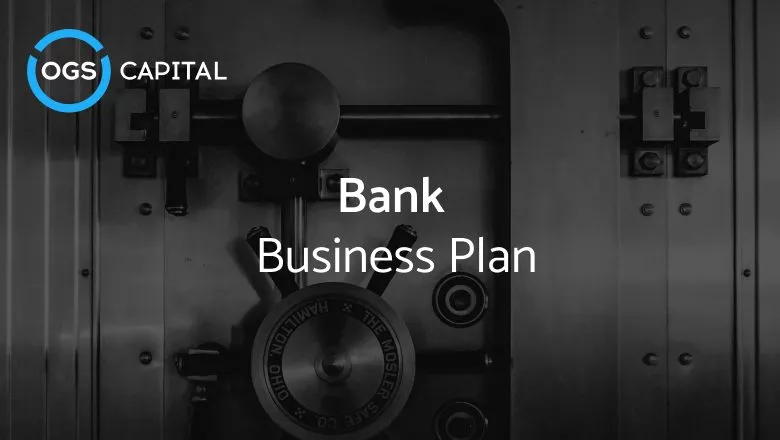
Table of Content
Bank Business Plan Checklist
A bank business plan is a document that describes the bank’s goals, strategies, operations, and financial projections. It communicates the bank’s vision and value proposition to potential investors, regulators, and stakeholders. A SBA business plan should be clear, concise, and realistic. It should also cover all the essential aspects of the bank’s business model.
Here is a checklist of the main sections that you should keep in mind while building a bank business plan:
- Executive summary
- Company description
- Industry analysis
- Competitive analysis
- Service or product list
- Marketing and sales plan
- Operations plan
- Management team
- Funding request
- Financial plan
Sample Business Plan for Bank
The following is a bank business plan template that operates in the USA. This bank business plan example is regarding ABC Bank, and it includes the following sections:
Executive Summary
ABC Bank is a new bank for California’s SMBs and individuals. We offer convenient banking services tailored to our customers’ needs and preferences. We have a large target market with over 500,000 SMBs spending billions on banking services annually. We have the licenses and approvals to operate our bank and raised $20 million in seed funding. We are looking for another $30 million in debt financing. By preparing a solid E2 visa business plan sample , entrepreneurs can utilize such banking models to secure their business immigration status in the U.S.
Our goal is to launch our bank by the end of 2024 and achieve the following objectives in the first five years of operation:
- Acquire 100,000 customers and 10% market share
- Generate $100 million in annual revenue and $20 million in net profit
- Achieve a return on equity (ROE) of 15% and a return on assets (ROA) of 1.5%
- Expand our network to 10 branches and 50 ATMs
- Increase our brand awareness and customer loyalty
Our bank has great potential to succeed and grow in the banking industry. We invite you to read the rest of our microfinance business plan to learn about how to set up a business plan for the bank and how we will achieve our goals.
Industry Analysis
California has one of the biggest and most active banking industries in the US and the world. According to the Federal Deposit Insurance Corp , California has 128 financial institutions, with total assets exceeding $560 billion.
The California banking industry is regulated and supervised by various federal and state authorities. However, they also face several risks and challenges, such as:
- High competition and consolidation
- Increasing regulation and compliance
- Rising customer demand for digital and mobile banking
- Cyberattacks and data breaches
- Environmental and social issues
The banking industry in California is highly competitive and fragmented. According to the FDIC, the top 10 banks and thrifts in California by total deposits as of June 30, 2023, were:
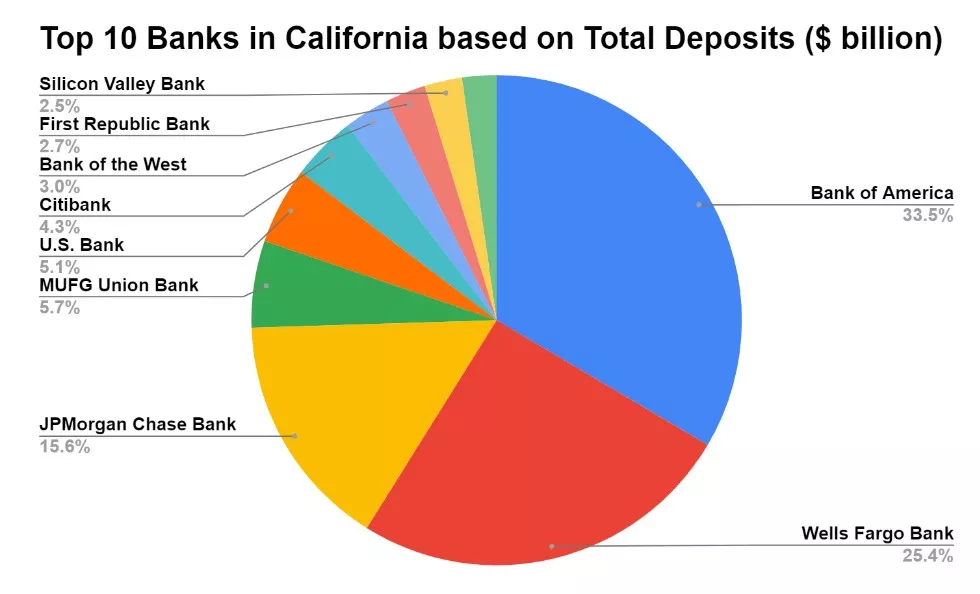
Customer Analysis
We serve SMBs who need local, easy, and cheap banking. We divide our customers into four segments by size, industry, location, and needs:
SMB Segment 1 – Tech SMBs in big cities of California. These are fast-growing, banking-intensive customers. They account for a fifth of our market share and a third of our revenue and are loyal and referable.
SMB Segment 2 – Entertainment SMBs in California’s entertainment hubs. These are high-profile, banking-heavy customers. They make up a sixth of our market and a fourth of our revenue and are loyal and influential.
SMB Segment 3 – Tourism SMBs in California’s tourist spots. These are seasonal, banking-dependent customers. They represent a quarter of our market and a fifth of our revenue and are loyal and satisfied.
SMB Segment 4 – Other SMBs in various regions of California. These are slow-growing, banking-light customers. They constitute two-fifths of our market and a quarter of our revenue and are loyal and stable.
Competitive Analysis
We compete with other banks and financial institutions that offer similar or substitute products and services to our target customers in our target market. We group our competitors into four categories based on their size and scope:
1. National Banks
- Key Players – Bank of America, Wells Fargo, JPMorgan Chase, Citibank, U.S. Bank
- Strengths – Large customer base, strong brand, extensive branch/ATM network, innovation, robust operations, solid financial performance
- Weaknesses – High competition, regulatory costs, low customer satisfaction, high attrition
- Strategies – Maintain dominance through customer acquisition/retention, revenue growth, efficiency
2. Regional Banks
- Key Players – MUFG Union Bank, Bank of the West, First Republic Bank, Silicon Valley Bank, East West Bank
- Strengths – Loyal customer base, brand recognition, convenient branch/ATM network, flexible operations
- Weaknesses – Moderate competition, regulatory costs, customer attrition
- Strategies – Grow market presence through customer acquisition/retention, revenue optimization, efficiency
3. Community Banks
- Key Players – Mechanics Bank, Bank of Marin, Pacific Premier Bank, Tri Counties Bank, Luther Burbank Savings
- Strengths – Small loyal customer base, reputation, convenient branches, ability to adapt
- Weaknesses – Low innovation and technology adoption
- Strategies – Maintain niche identity through customer loyalty, revenue optimization, efficiency
4. Online Banks
- Key Players – Ally Bank, Capital One 360, Discover Bank, Chime Bank, Varo Bank
- Strengths – Large growing customer base, strong brand, no branches, lean operations, high efficiency
- Weaknesses – High competition, regulatory costs, low customer satisfaction and trust, high attrition
- Strategies – Disrupt the industry by acquiring/retaining customers, optimizing revenue, improving efficiency
Market Research
Our market research shows that:
- California has a large, competitive, growing banking market with 128 banks and $560 billion in assets.
- Our target customers are the SMBs in California, which is 99.8% of the businesses and employ 7.2-7.4 million employees.
- Our main competitors are national and regional banks in California that offer similar banking products and services.
We conclude that:
- Based on the information provided in our loan officer business plan , there is a promising business opportunity for us to venture into and establish a presence in the banking market in California.
- We should focus on the SMBs in California, as they have various unmet banking needs, preferences, behavior, and a high potential for growth and profitability.
Operations Plan
Our operational structure and processes form the basis of our operations plan, and they are as follows:
- Location and Layout – We have a network of 10 branches and 50 ATMs across our target area in California. We strategically place our branches and ATMs in convenient and high-traffic locations.
- Equipment and Technology – We use modern equipment and technology to provide our products and services. We have computers and software for banking functions; security systems to protect branches and ATMs; communication systems to communicate with customers and staff; inventory and supplies to operate branches and ATMs.
- Suppliers and Vendors – We work with reliable suppliers and vendors that provide our inventory and supplies like cash, cards, paper, etc. We have supplier management systems to evaluate performance.
- Staff and Management – Our branches have staff like branch managers, customer service representatives, tellers, and ATM technicians with suitable qualifications and experience.
- Policies and Procedures – We have policies for customer service, cash handling, card handling, and paper handling to ensure quality, minimize losses, and comply with regulations. We use various tools and systems to implement these policies.
Management Team
The following individuals make up our management team:
- Earl Yao, CEO and Founder – Earl is responsible for establishing and guiding the bank’s vision, mission, strategy, and overall operations. He brings with him over 20 years of banking experience.
- Paula Wells, CFO and Co-Founder – Paula oversees financial planning, reporting, analysis, compliance, and risk management.
- Mark Hans, CTO – Mark leads our technology strategy, infrastructure, innovation, and digital transformation.
- Emma Smith, CMO – Emma is responsible for designing and implementing our marketing strategy and campaigns.
- David O’kane, COO – David manages the daily operations and processes of the bank ensuring our products and services meet the highest standards of quality and efficiency.
Financial Projections
Our assumptions and drivers form the basis of our financial projections, which are as follows:
Assumptions: We have made the following assumptions for our collection agency business plan :
- Start with 10 branches, 50 ATMs in January 2024
- Grow branches and ATMs 10% annually
- 10,000 customers per branch, 2,000 per ATM
- 5% average loan rate, 2% average deposit rate
- 80% average loan-to-deposit ratio
- $10 average fee per customer monthly
- $100,000 average operating expense per branch monthly
- $10,000 average operating expense per ATM monthly
- 25% average tax rate
Our financial projections are as per our:
- Projected Income Statement
- Projected Cash Flow Statement
- Projected Balance Sheet
- Projected Financial Ratios and Indicators
Select the Legal Framework for Your Bank
Our legal structure and requirements form the basis of our legal framework, which are as follows:
Legal Structure and Entity – We have chosen to incorporate our bank as a limited liability company (LLC) under the laws of California.
Members – We have two members who own and control our bank: Earl Yao and Paula Wells, the founders and co-founders of our bank.
Manager – We have appointed Mark Hans as our manager who oversees our bank’s day-to-day operations and activities.
Name – We have registered our bank’s name as ABC Bank LLC with the California Secretary of State. We have also obtained a trademark registration for our name and logo.
Registered Agent – We have designated XYZ Registered Agent Services LLC as our registered agent authorized to receive and handle legal notices and documents on behalf of our bank.
Licenses and Approvals – We have obtained the necessary licenses and approvals to operate our bank in California, including:
- Federal Deposit Insurance Corporation (FDIC) Insurance
- Federal Reserve System Membership
- California Department of Financial Protection and Innovation (DFPI) License
- Business License
- Employer Identification Number (EIN)
- Zoning and Building Permits
Legal Documents and Agreements – We have prepared and signed the necessary legal documents and agreements to form and operate our bank, including:
- Certificate of Formation
- Operating Agreement
- Membership Agreement
- Loan Agreement
- Card Agreement
- Paper Agreement
Keys to Success
We analyze our market, customers, competitors, and industry to determine our keys to success. We have identified the following keys to success for our bank.
Customer Satisfaction
Customer satisfaction is vital for any business, especially a bank relying on loyalty and referrals. It is the degree customers are happy with our products, services, and interactions. It is influenced by:
- Product and service quality – High-quality products and services that meet customer needs and preferences
- Customer service quality – Friendly, professional, and helpful customer service across channels
- Customer experience quality – Convenient, reliable, and secure customer access and transactions
We will measure satisfaction with surveys, feedback, mystery shopping, and net promoter scores. Our goal is a net promoter score of at least 8.
Operational Efficiency
Efficiency is key in a regulated, competitive environment. It is using resources and processes effectively to achieve goals and objectives. It is influenced by:
- Resource optimization – Effective and efficient use and control of capital, staff, and technology
- Process improvement – Streamlined, standardized processes measured for performance
- Performance management – Managing financial, operational, customer, and stakeholder performance
We will measure efficiency with KPIs, metrics, dashboards, and operational efficiency ratios. Our goal is an operational efficiency ratio below 50%.
Partner with OGSCapital for Your Bank Business Plan Success
Highly efficient service.
Highly Efficient Service! I am incredibly happy with the outcome; Alex and his team are highly efficient professionals with a diverse bank of knowledge.
Are you looking to hire business plan writers to start a bank business plan? At OGSCapital, we can help you create a customized and high-quality bank development business plan to meet your goals and exceed your expectations.
We have a team of senior business plan experts with extensive experience and expertise in various industries and markets. We will conduct thorough market research, develop a unique value proposition, design a compelling financial model, and craft a persuasive pitch deck for your business plan. We will also offer you strategic advice, guidance, and access to a network of investors and other crucial contacts.
We are not just a business plan writing service. We are a partner and a mentor who will support you throughout your entrepreneurial journey. We will help you achieve your business goals with smart solutions and professional advice. Contact us today and let us help you turn your business idea into a reality.
Frequently Asked Questions
How do I start a small bank business?
To start a small bank business in the US, you need to raise enough capital, understand how to make a business plan for the bank, apply for a federal or state charter, register your bank for taxes, open a business bank account, set up accounting, get the necessary permits and licenses, get bank insurance, define your brand, create your website, and set up your phone system.
Are banks profitable businesses?
Yes, banks are profitable businesses in the US. They earn money through interest on loans and fees for other services. The commercial banking industry in the US has grown 5.6% per year on average between 2018 and 2023.
Download Bank Business Plan Sample in pdf
OGSCapital’s team has assisted thousands of entrepreneurs with top-rated document, consultancy and analysis. They’ve helped thousands of SME owners secure more than $1.5 billion in funding, and they can do the same for you.

Any questions? Get in Touch!
We have been mentioned in the press:
Leave a Reply Cancel reply
Your email address will not be published. Required fields are marked *
Save my name, email, and website in this browser for the next time I comment.
Search the site:

How to Write a Successful Bank Business Plan (+ Template)

Creating a business plan is essential. Still, it can be beneficial for bank s that want to improve their strategy or raise funding.
A well-crafted business plan outlines your company’s vision and documents a step-by-step roadmap of how you will accomplish it. To create an effective business plan, you must first understand the components essential to its success.
This article provides an overview of the key elements that every bank business owner should include in their business plan.
Download the Ultimate Business Plan Template
What is a Bank Business Plan?
A bank business plan is a formal written document describing your company’s business strategy and feasibility. It documents the reasons you will be successful, your areas of competitive advantage, and it includes information about your team members. Your business plan is a critical document that will convince investors and lenders (if needed) that you are positioned to become a successful venture.
Why Write a Bank Business Plan?
A bank business plan is required for banks and investors. The document is a clear and concise guide of your business idea and the steps you will take to make it profitable.
Entrepreneurs can also use this as a roadmap when starting their new company or venture, especially if they are inexperienced in starting a business.
Writing an Effective Bank Business Plan
The following are the key components of a successful bank business plan:
Executive Summary
The executive summary of a bank business plan is a one- to two-page overview of your entire business plan. It should summarize the main points, which will be presented in full in the rest of your business plan.
- Start with a one-line description of your bank company
- Provide a summary of the key points in each section of your business plan, which includes information about your company’s management team, industry analysis, competitive analysis, and financial forecast, among others.
Company Description
This section should include a brief history of your company. Include a short description of how your company started and provide a timeline of milestones your company has achieved.
You may not have a long company history if you are just starting your bank business. Instead, you can include information about your professional experience in this industry and how and why you conceived your new venture. If you have worked for a similar company or been involved in an entrepreneurial venture before starting your bank firm, mention this.
You will also include information about your chosen bank business model and how, if applicable, it is different from other companies in your industry.
Industry Analysis
The industry or market analysis is an essential component of a bank business plan. Conduct thorough market research to determine industry trends and document the size of your market.
Questions to answer include:
- What part of the bank industry are you targeting?
- How big is the market?
- What trends are happening in the industry right now (and if applicable, how do these trends support your company’s success)?
You should also include sources for your information, such as published research reports and expert opinions.
Customer Analysis
This section should include a list of your target audience(s) with demographic and psychographic profiles (e.g., age, gender, income level, profession, job titles, interests). You will need to provide a profile of each customer segment separately, including their needs and wants.
For example, a bank business’ customers may include small businesses, large corporations, and individuals. Each customer segment will have different requirements that your bank company will need to cater to.
You can include information about how your customers decide to buy from you and what keeps them buying from you.
Develop a strategy for targeting those customers who are most likely to buy from you, as well as those that might be influenced to buy your products or bank services with the right marketing.
Competitive Analysis
The competitive analysis helps you determine how your product or service will differ from competitors, and what your unique selling proposition (USP) might be that will set you apart in this industry.
For each competitor, list their strengths and weaknesses. Next, determine your areas of competitive advantage; that is, in what ways are you different from and ideally better than your competitors.
Below are sample competitive advantages your bank business may have:
- Proven track record with a focus on customer service.
- Superior technology that makes banking easier and more convenient for customers.
- Range of products and services to meet the needs of different customer segments.
- Sound financial position with a commitment to responsible lending practices.
- Extensive branch and ATM network.
Marketing Plan
This part of the business plan is where you determine and document your marketing plan. . Your plan should be laid out, including the following 4 Ps.
- Product/Service : Detail your product/service offerings here. Document their features and benefits.
- Price : Document your pricing strategy here. In addition to stating the prices for your products/services, mention how your pricing compares to your competition.
- Place : Where will your customers find you? What channels of distribution (e.g., partnerships) will you use to reach them if applicable?
- Promotion : How will you reach your target customers? For example, you may use social media, write blog posts, create an email marketing campaign, use pay-per-click advertising, or launch a direct mail campaign. Or you may promote your bank business via PR or events.
Operations Plan
This part of your bank business plan should include the following information:
- How will you deliver your product/service to customers? For example, will you do it in person or over the phone?
- What infrastructure, equipment, and resources are needed to operate successfully? How can you meet those requirements within budget constraints?
You also need to include your company’s business policies in the operations plan. You will want to establish policies related to everything from customer service to pricing, to the overall brand image you are trying to present.
Finally, and most importantly, your Operations Plan will outline the milestones your company hopes to achieve within the next five years. Create a chart that shows the key milestone(s) you hope to achieve each quarter for the next four quarters, and then each year for the following four years. Examples of milestones for a bank business include reaching $X in sales. Other examples include expanding to new markets, launching new products and services, and hiring key personnel.
Management Team
List your team members here, including their names and titles, as well as their expertise and experience relevant to your specific bank industry. Include brief biography sketches for each team member.
Particularly if you are seeking funding, the goal of this section is to convince investors and lenders that your team has the expertise and experience to execute on your plan. If you are missing key team members, document the roles and responsibilities you plan to hire for in the future.
Financial Plan
Here, you will include a summary of your complete and detailed financial plan (your full financial projections go in the Appendix).
This includes the following three financial statements:
Income Statement
Your income statement should include:
- Revenue : how much revenue you generate.
- Cost of Goods Sold : These are your direct costs associated with generating revenue. This includes labor costs and the cost of any equipment and supplies used to deliver the product/service offering.
- Net Income (or loss) : Once expenses and revenue are totaled and deducted from each other, this is the net income or loss.
Sample Income Statement for a Startup Bank
| Revenues | $ 336,090 | $ 450,940 | $ 605,000 | $ 811,730 | $ 1,089,100 |
| $ 336,090 | $ 450,940 | $ 605,000 | $ 811,730 | $ 1,089,100 | |
| Direct Cost | |||||
| Direct Costs | $ 67,210 | $ 90,190 | $ 121,000 | $ 162,340 | $ 217,820 |
| $ 67,210 | $ 90,190 | $ 121,000 | $ 162,340 | $ 217,820 | |
| $ 268,880 | $ 360,750 | $ 484,000 | $ 649,390 | $ 871,280 | |
| Salaries | $ 96,000 | $ 99,840 | $ 105,371 | $ 110,639 | $ 116,171 |
| Marketing Expenses | $ 61,200 | $ 64,400 | $ 67,600 | $ 71,000 | $ 74,600 |
| Rent/Utility Expenses | $ 36,400 | $ 37,500 | $ 38,700 | $ 39,800 | $ 41,000 |
| Other Expenses | $ 9,200 | $ 9,200 | $ 9,200 | $ 9,400 | $ 9,500 |
| $ 202,800 | $ 210,940 | $ 220,871 | $ 230,839 | $ 241,271 | |
| EBITDA | $ 66,080 | $ 149,810 | $ 263,129 | $ 418,551 | $ 630,009 |
| Depreciation | $ 5,200 | $ 5,200 | $ 5,200 | $ 5,200 | $ 4,200 |
| EBIT | $ 60,880 | $ 144,610 | $ 257,929 | $ 413,351 | $ 625,809 |
| Interest Expense | $ 7,600 | $ 7,600 | $ 7,600 | $ 7,600 | $ 7,600 |
| $ 53,280 | $ 137,010 | $ 250,329 | $ 405,751 | $ 618,209 | |
| Taxable Income | $ 53,280 | $ 137,010 | $ 250,329 | $ 405,751 | $ 618,209 |
| Income Tax Expense | $ 18,700 | $ 47,900 | $ 87,600 | $ 142,000 | $ 216,400 |
| $ 34,580 | $ 89,110 | $ 162,729 | $ 263,751 | $ 401,809 | |
| 10% | 20% | 27% | 32% | 37% | |
Balance Sheet
Include a balance sheet that shows your assets, liabilities, and equity. Your balance sheet should include:
- Assets : Everything you own (including cash).
- Liabilities : This is what you owe against your company’s assets, such as accounts payable or loans.
- Equity : The worth of your business after all liabilities and assets are totaled and deducted from each other.
Sample Balance Sheet for a Startup Bank
| Cash | $ 105,342 | $ 188,252 | $ 340,881 | $ 597,431 | $ 869,278 |
| Other Current Assets | $ 41,600 | $ 55,800 | $ 74,800 | $ 90,200 | $ 121,000 |
| Total Current Assets | $ 146,942 | $ 244,052 | $ 415,681 | $ 687,631 | $ 990,278 |
| Fixed Assets | $ 25,000 | $ 25,000 | $ 25,000 | $ 25,000 | $ 25,000 |
| Accum Depreciation | $ 5,200 | $ 10,400 | $ 15,600 | $ 20,800 | $ 25,000 |
| Net fixed assets | $ 19,800 | $ 14,600 | $ 9,400 | $ 4,200 | $ 0 |
| $ 166,742 | $ 258,652 | $ 425,081 | $ 691,831 | $ 990,278 | |
| Current Liabilities | $ 23,300 | $ 26,100 | $ 29,800 | $ 32,800 | $ 38,300 |
| Debt outstanding | $ 108,862 | $ 108,862 | $ 108,862 | $ 108,862 | $ 0 |
| $ 132,162 | $ 134,962 | $ 138,662 | $ 141,662 | $ 38,300 | |
| Share Capital | $ 0 | $ 0 | $ 0 | $ 0 | $ 0 |
| Retained earnings | $ 34,580 | $ 123,690 | $ 286,419 | $ 550,170 | $ 951,978 |
| $ 34,580 | $ 123,690 | $ 286,419 | $ 550,170 | $ 951,978 | |
| $ 166,742 | $ 258,652 | $ 425,081 | $ 691,831 | $ 990,278 | |
Cash Flow Statement
Include a cash flow statement showing how much cash comes in, how much cash goes out and a net cash flow for each year. The cash flow statement should include cash flow from:
- Investments
Below is a sample of a projected cash flow statement for a startup bank business.
Sample Cash Flow Statement for a Startup Bank
| Net Income (Loss) | $ 34,580 | $ 89,110 | $ 162,729 | $ 263,751 | $ 401,809 |
| Change in Working Capital | $ (18,300) | $ (11,400) | $ (15,300) | $ (12,400) | $ (25,300) |
| Plus Depreciation | $ 5,200 | $ 5,200 | $ 5,200 | $ 5,200 | $ 4,200 |
| Net Cash Flow from Operations | $ 21,480 | $ 82,910 | $ 152,629 | $ 256,551 | $ 380,709 |
| Fixed Assets | $ (25,000) | $ 0 | $ 0 | $ 0 | $ 0 |
| Net Cash Flow from Investments | $ (25,000) | $ 0 | $ 0 | $ 0 | $ 0 |
| Cash from Equity | $ 0 | $ 0 | $ 0 | $ 0 | $ 0 |
| Cash from Debt financing | $ 108,862 | $ 0 | $ 0 | $ 0 | $ (108,862) |
| Net Cash Flow from Financing | $ 108,862 | $ 0 | $ 0 | $ 0 | $ (108,862) |
| Net Cash Flow | $ 105,342 | $ 82,910 | $ 152,629 | $ 256,551 | $ 271,847 |
| Cash at Beginning of Period | $ 0 | $ 105,342 | $ 188,252 | $ 340,881 | $ 597,431 |
| Cash at End of Period | $ 105,342 | $ 188,252 | $ 340,881 | $ 597,431 | $ 869,278 |
You will also want to include an appendix section which will include:
- Your complete financial projections
- A complete list of your company’s business policies and procedures related to the rest of the business plan (marketing, operations, etc.)
- Any other documentation which supports what you included in the body of your business plan.
Writing a good business plan gives you the advantage of being fully prepared to launch and grow your bank company. It not only outlines your business vision but also provides a step-by-step process of how you will accomplish it.
Now that you know how to write a business plan for your bank, you can get started on putting together your own.
Finish Your Business Plan in 1 Day!
Wish there was a faster, easier way to finish your business plan?
With our Ultimate Business Plan Template you can finish your plan in just 8 hours or less!
Other Helpful Articles
Commercial Bank Business Plan
Investment Bank Business Plan
Digital Bank Business Plan
We earn commissions if you shop through the links below. Read more
Back to All Business Ideas
How to Start a Bank: Planning, Funding, and Execution
Written by: Carolyn Young
Carolyn Young is a business writer who focuses on entrepreneurial concepts and the business formation. She has over 25 years of experience in business roles, and has authored several entrepreneurship textbooks.
Edited by: David Lepeska
David has been writing and learning about business, finance and globalization for a quarter-century, starting with a small New York consulting firm in the 1990s.
Published on June 20, 2022
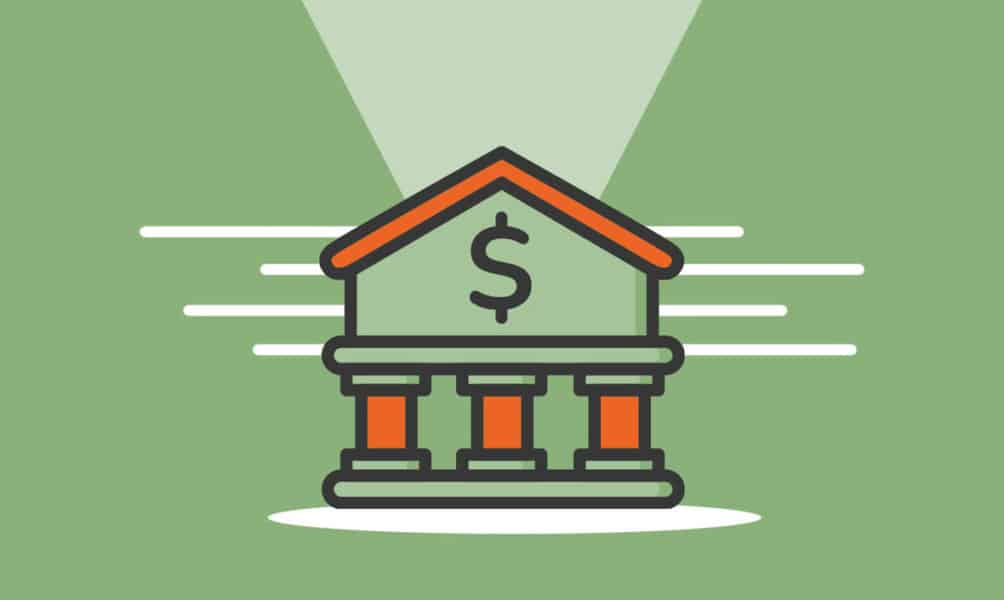
Investment range
$13,385,150 - $28,710,200
Revenue potential
$7.2 million - $72 million p.a.
Time to build
12 – 18 months
Profit potential
$720,000 - $7.2 million p.a.
Industry trend
Here are the most important factors to consider when starting a bank:
- Licensing — You will need many licenses and approvals to start a bank. The primary one is the Banking License . Next, you will need to apply for regulatory approval from a central bank. In addition, banks must comply with AML and KYC regulations to prevent financial crimes.
- ATMs and Branches — If your bank plans to open branches or install ATMs, depending on local laws, additional permissions may be required for each location.
- Capital — Regulators will require that you maintain certain levels of capital to cover potential losses. These requirements can be quite high and are meant to ensure the bank’s stability and solvency.
- Insurance — In many jurisdictions, banks are required to insure deposits up to a certain amount. This insurance protects depositors in the event of a bank failure.
- Location — Find a location that’s in a busy commercial area or business district.
- Security — Invest in high-quality physical security such as alarm systems, surveillance cameras, secure vaults, and secure doors. In addition, consider robust cybersecurity measures to protect sensitive data such as encryption, storage solutions, and strict access controls.
- Register your business — A limited liability company (LLC) is the best legal structure for new businesses because it is fast and simple. Form your business immediately using ZenBusiness LLC formation service or hire one of the best LLC services on the market.
- Legal business aspects — Register for taxes, open a business bank account, and get an EIN .
Interactive Checklist at your fingertips—begin your bank today!
You May Also Wonder:
How profitable are banks?
Banks are very profitable, considering that the U.S. banking industry is worth more than $860 billion. The key is to provide a variety of banking services and offer great customer service.
How do I build relationships with customers and attract deposits to my bank?
You’ll have to spend some time marketing to get the word out. Then, when customers come in, you’ll want them to receive personal service.
How do I develop a business plan for my bank?
A business plan is a detailed document that requires considerable time to develop. It includes various sections such as an executive summary, company overview, descriptions of your products and services, market analysis, competitor analysis, sales and marketing plan, management summary, operations plan, and financial projections.
How do I create a risk management plan for my bank?
A risk management plan for a bank is very complex. Your best bet is to hire an experienced banking consultant to help you. It will be worth the cost.
What is the difference between a commercial bank and a community bank?
Commercial banks generally operate nationally and are subject to federal multi-state banking regulations. Community banks only operate in one state or locality.
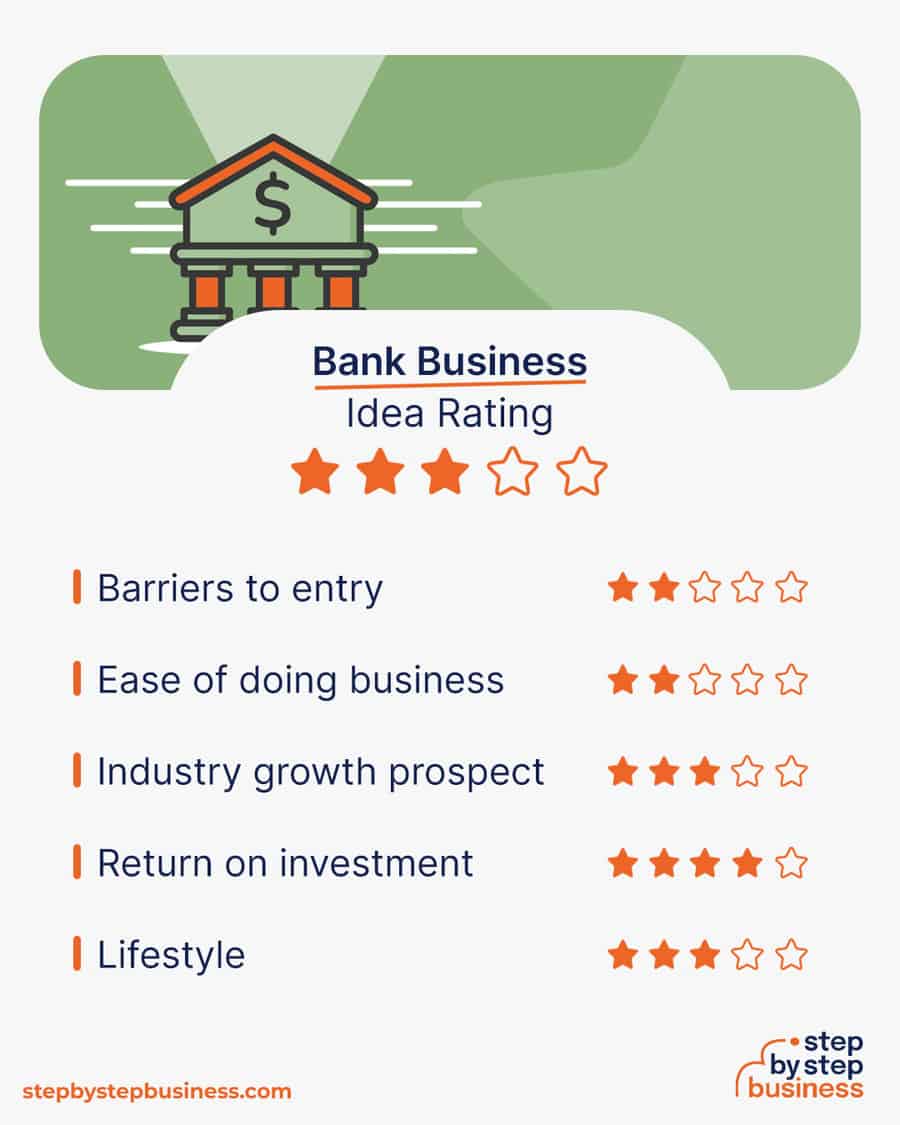
Step 1: Decide if the Business Is Right for You
Pros and cons.
Starting a bank has pros and cons to consider before deciding if it’s right for you.
- Provide value — Crucial financial services for your community
- Large market — Most people rely on banks
- Good money — Banks are big money makers
- Large investment — Millions in starting capital required
- Highly regulated — Banking is the most regulated industry in the US
Bank Industry Trends
Industry size and growth.
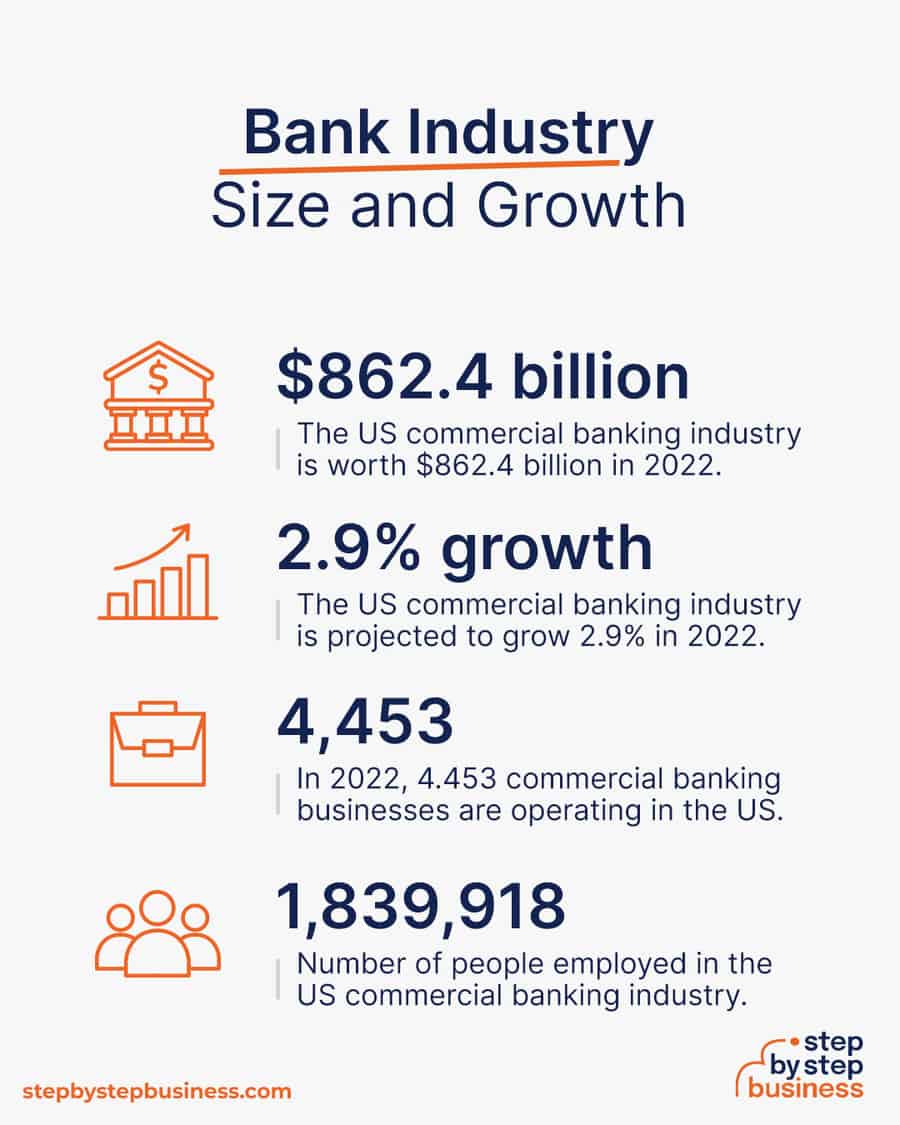
- Industry size and past growth — The US commercial banking industry was worth $1.4 trillion in 2023 after expanding 37.3% since 2022. On average, the industry has grown 5.6% over the last five years.(( https://www.ibisworld.com/industry-statistics/market-size/commercial-banking-united-states/ ))
- Growth forecast — The US commercial banking industry is projected to grow more than 2% yearly by 2029.(( https://www.mordorintelligence.com/industry-reports/us-commercial-banking-market ))
- Number of businesses — In 2023, 4,867 commercial banking businesses were operating in the US.(( https://www.ibisworld.com/industry-statistics/number-of-businesses/commercial-banking-united-states/ ))
- Number of people employed — In 2023, the US commercial banking industry employed 2,595,852 people.(( https://www.ibisworld.com/industry-statistics/employment/commercial-banking-united-states/ ))
Trends and Challenges
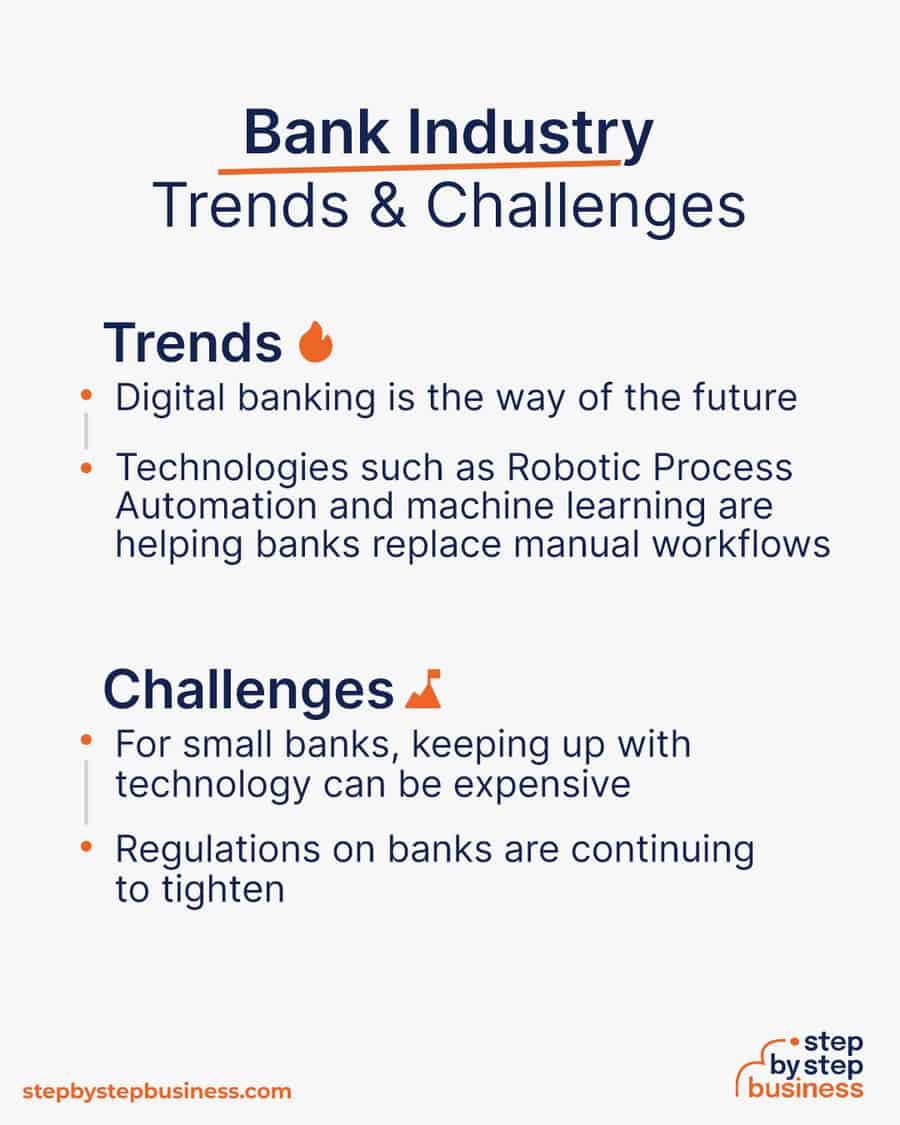
- Digital banking is the way of the future, with major banks competing to have the best apps, websites, and digital services, like instant payments.
- Technologies such as Robotic Process Automation and machine learning are helping banks replace manual workflows with cost-efficient, lightning-fast operations.
- For small banks, keeping up with technology to compete with major banks can be expensive.
- Regulations on banks — already the country’s most regulated industry — are continuing to tighten, creating new expenses and operational challenges.
Demand Hotspots
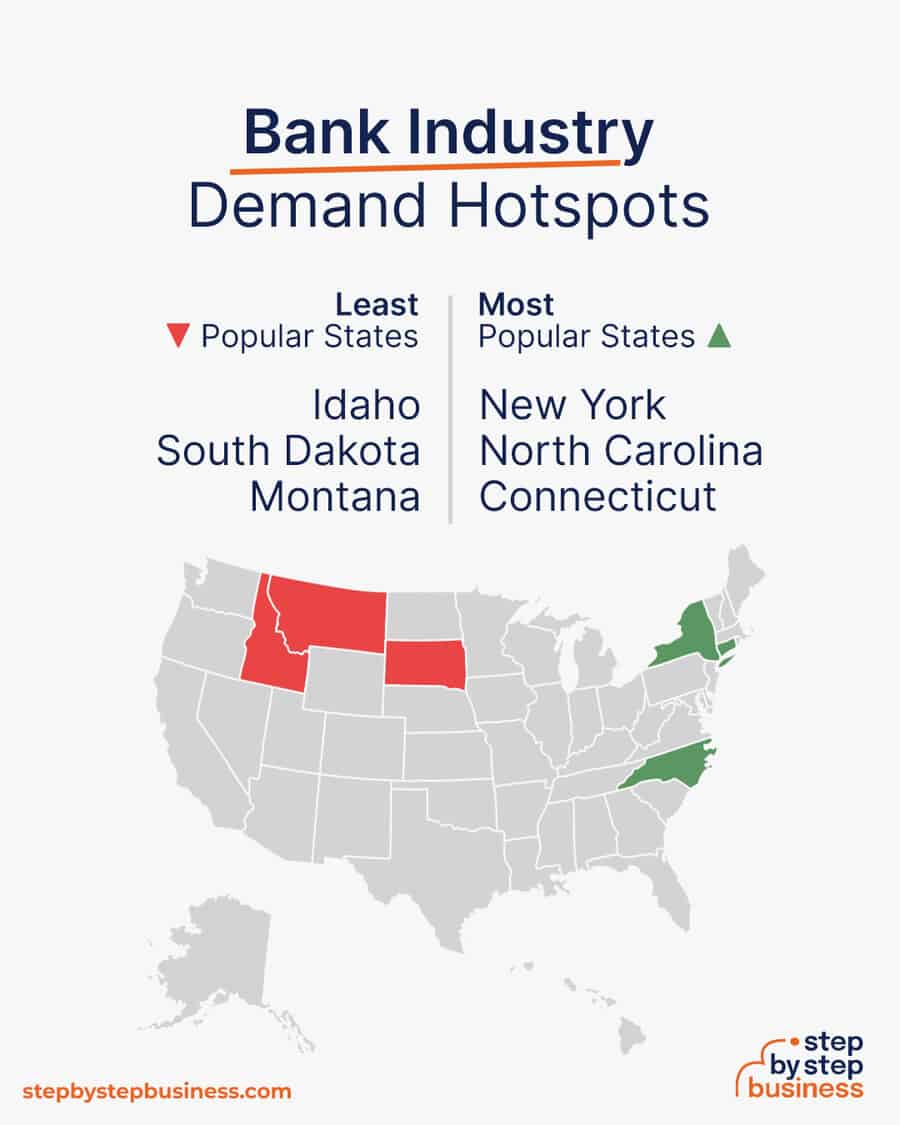
- Most popular states — The most popular states for bank managers are New York, California, and Washington.
- Least popular states — The least popular states for bank managers are Nebraska, Wyoming, and North Dakota.(( https://www.zippia.com/bank-manager-jobs/best-states/ ))
What Kind of People Work in Banks?
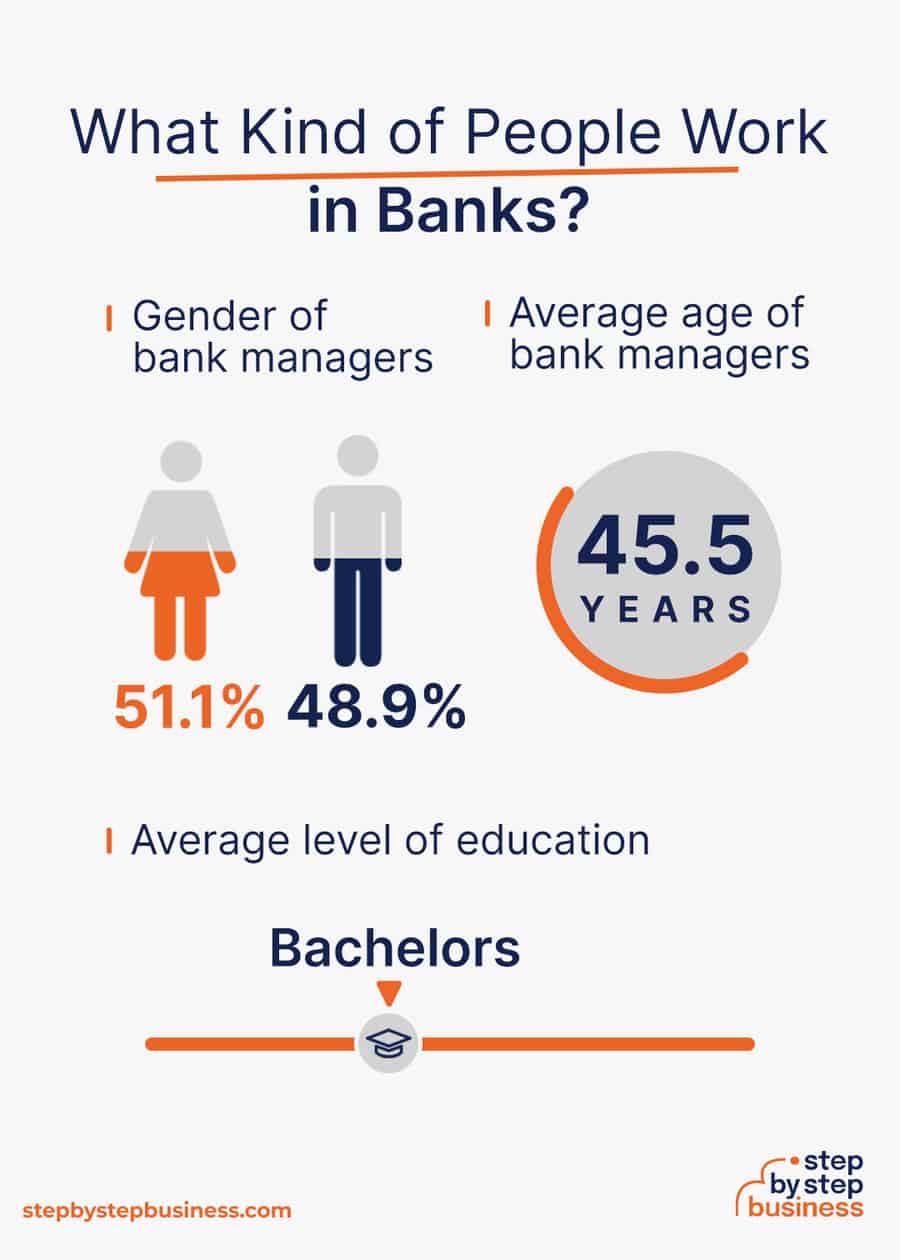
- Gender — 51.1% of bank managers are female, while 48.9% are male.
- Average level of education — The average bank manager has a bachelor’s degree.
- Average age — The average bank manager in the US is 45.8 years old.(( https://www.zippia.com/bank-manager-jobs/demographics/ ))
How Much Does It Cost to Start a Bank Business?
Startup costs for a bank range from $13 million to $28 million, with the biggest expense being the startup capital required to meet federal regulations. If you start a digital rather than a physical bank, you could save up to $4 million.
You will need to apply for licenses and insurance with the Federal Reserve and the Federal Deposit Insurance Corporation (FDIC) , which is often a laborious process.
You’ll need a handful of items to successfully launch your bank business, including:
- Computer system
- Printers, money counters, other office equipment
- Security system
- Furnishings
| Start-up Costs | Ballpark Range | Average |
|---|---|---|
| Setting up a business name and corporation | $150–$200 | $175 |
| Business licenses and permits | $10,000–$20,000 | $15,000 |
| Insurance | $25,000–$50,000 | $37,500 |
| Website and app development | $100,000–$150,000 | $125,000 |
| Land plus bank construction | $1,000,000–$4,000,000 | $2,500,000 |
| Computer system | $30,000–$50,000 | $40,000 |
| Starting capital to meet regulations | $12,000,000–$24,000,000 | $18,000,000 |
| Labor and operating budget | $200,000–$400,000 | $300,000 |
| Bank furnishings and equipment | $20,000–$40,000 | $30,000 |
| Total | $13,385,150–$28,710,200 | $21,047,675 |
How Much Can You Earn From a Bank Business?
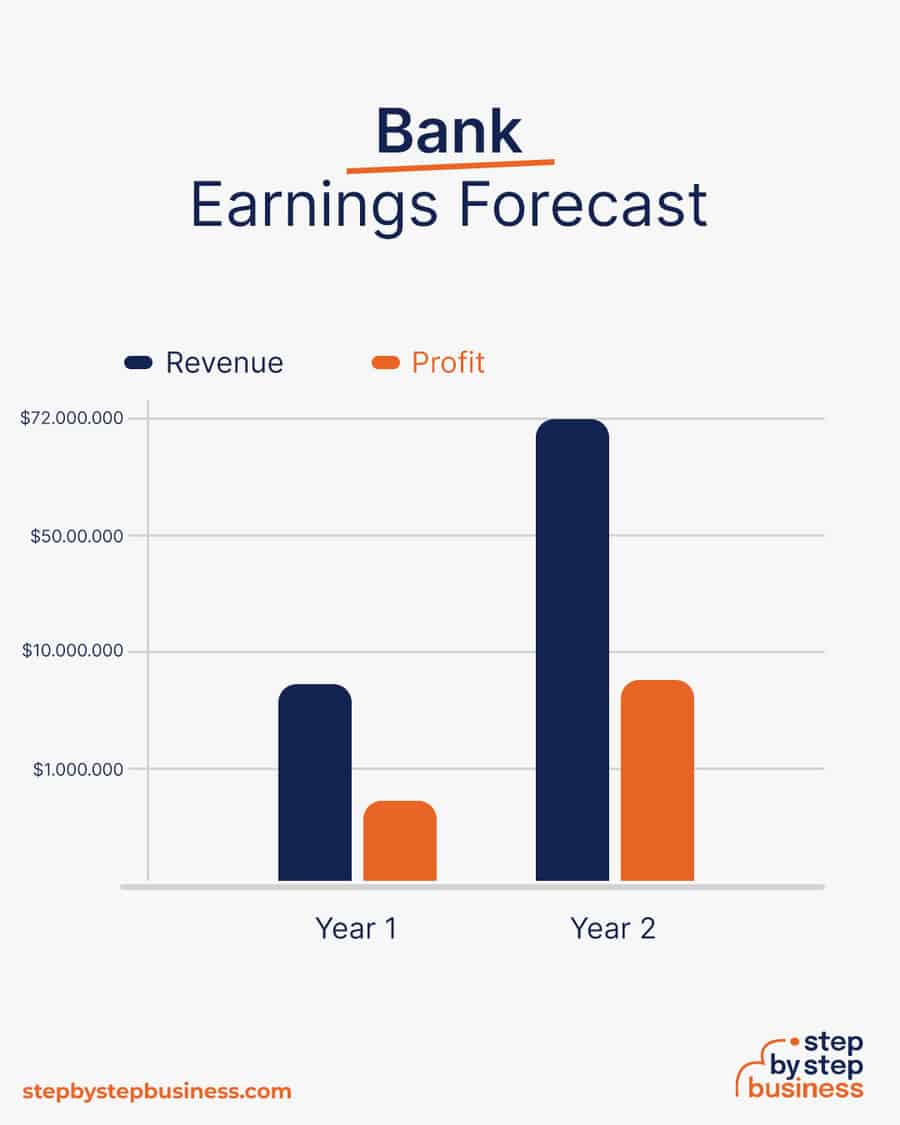
Banks make money from fees and from the interest on loans that they make. The profit margin of a bank is typically about 10%.
In your first year or two, you might get 10,000 customers and make $100,000 in fees per month and $500,000 in interest, bringing in $7,200,000 in annual revenue. This would mean $720,000 in profit, assuming that 10% margin. As you build your customer base, those numbers might increase tenfold. With annual revenue of $72,000,000, you’d make an outstanding profit of $7.2 million.
What Barriers to Entry Are There?
There are a few barriers to entry for a bank. Your biggest challenges will be:
- A large amount of initial capital
- Understanding the complex administrative processes
- Navigating the regulatory environment
Related Business Ideas
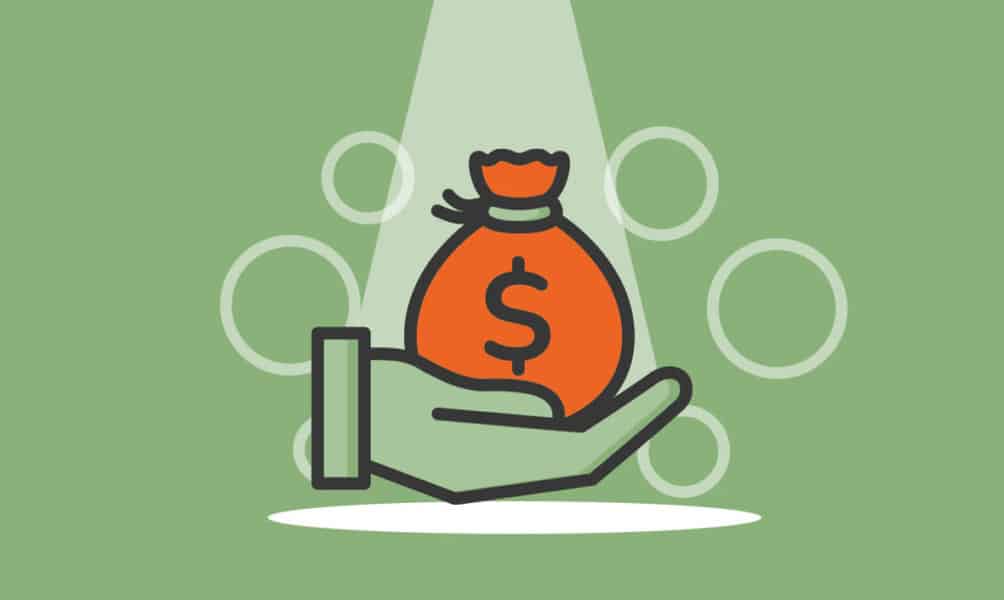
From Capital to Cash Flow: Starting a Money Lending Business
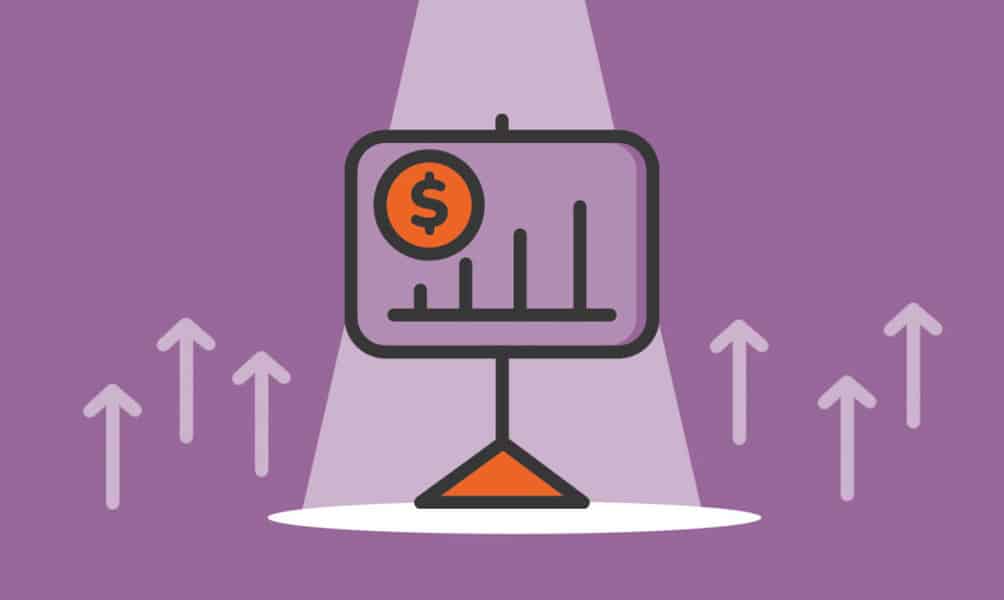
From Advice to Assets: Starting a Financial Coaching Business
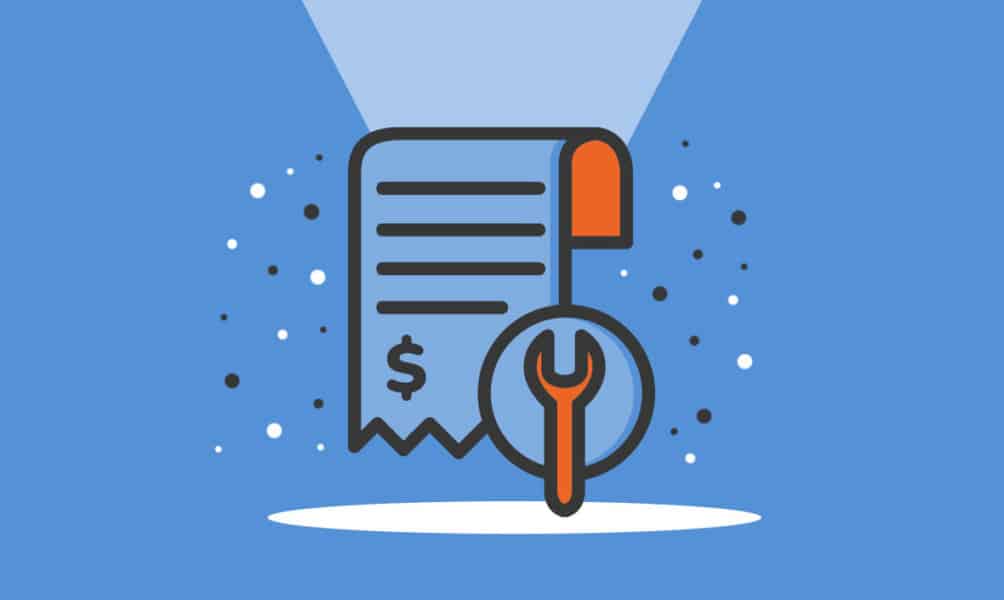
The Essentials of Starting a Credit Repair Business
Step 2: hone your idea.
Now that you know what’s involved in starting a bank, it’s a good idea to hone your concept in preparation to enter a competitive market.
Market research will give you the upper hand, even if you’re already positive that you have a perfect product or service. Conducting market research is important, because it can help you understand your customers better, who your competitors are, and your business landscape.
Why? Identify an Opportunity
Research banks in your area to examine their products and services, price points, and customer reviews. You’re looking for a market gap to fill. For instance, maybe the local market is missing a community bank that offers free checking accounts or an online bank that offers money market accounts.
You might consider targeting a niche market by specializing in a certain aspect of your industry, such as savings accounts and mortgage loans, or business accounts and loans.
This could jumpstart your word-of-mouth marketing and attract clients right away.
What? Determine Your Financial Products and Services
Banks offer a variety of products and services, including:
- Checking accounts
- Savings accounts
- Money market accounts
- Mortgage loans and other loans
- Credit cards
- Wealth management services
How Much Should You Charge for Bank Services?
Account fees can range from $5 to $15 per month. Banks also charge fees for overdrafts, ATMs, and other services. Loan rates will be dictated by the current market environment. The profit margin for banks is generally about 10%.
Once you know your costs, you can use our profit margin calculator to determine your markup and final price points. Remember, the prices you use at launch should be subject to change if warranted by the market.
Who? Identify Your Target Market
Your target market will be basically anyone. You should spread out your marketing to include TikTok, Instagram, Facebook, and LinkedIn.
Where? Choose Your Bank Location
Selecting the right location for your bank is crucial for its success. Look for a location in a high-traffic area, preferably in a commercial district or near other financial institutions. You can find commercial space to rent in your area on sites such as Craigslist , Crexi , and Instant Offices .
Consider the accessibility and convenience for clients, with easy access to parking and public transportation. Additionally, you should analyze the demographics of the surrounding area to ensure there is a demand for banking services.
By choosing a strategic location, you can position your bank to attract a wide range of customers and establish a strong presence in the financial industry.
Step 3: Brainstorm a Bank Name
Here are some ideas for brainstorming your business name:
- Short, unique, and catchy names tend to stand out
- Names that are easy to say and spell tend to do better
- Name should be relevant to your product or service offerings
- Ask around — family, friends, colleagues, social media — for suggestions
- Including keywords, such as “bank” or “community bank,” boosts SEO
- Name should allow for expansion, for example, “Peak Performance Bank” over “Student Loan Bank”
- A location-based name can help establish a strong connection with your local community and help with the SEO but might hinder future expansion
Discover over 290 unique bank business name ideas here . If you want your business name to include specific keywords, you can also use our bank business name generator. Just type in a few keywords, hit Generate, and you’ll have dozens of suggestions at your fingertips.
Once you’ve got a list of potential names, visit the website of the US Patent and Trademark Office to make sure they are available for registration and check the availability of related domain names using our Domain Name Search tool. Using “.com” or “.org” sharply increases credibility, so it’s best to focus on these.
Find a Domain
Powered by GoDaddy.com
Finally, make your choice among the names that pass this screening and go ahead with domain registration and social media account creation. Your business name is one of the key differentiators that sets your business apart. However, once you start with the branding, it is hard to change the business name. Therefore, it’s important to carefully consider your choice before you start a business entity.
Step 4: Create a Bank Business Plan
Here are the key components of a business plan:

- Executive summary — A concise summary highlighting the key points of the business plan, including its mission, goals, and financial projections
- Business overview — An overview of the business, detailing its mission, vision, values, and the problem it aims to solve or the need it fulfills
- Product and services — A detailed description of the products and services offered by the business, emphasizing their unique selling points and value proposition
- Market analysis — A comprehensive analysis of the target market, including demographics, trends, and potential opportunities and challenges
- Competitive analysis — An assessment of the competitive landscape, identifying key competitors, their strengths and weaknesses, and the business’s competitive advantage
- Sales and marketing — A strategy outlining how the business plans to promote and sell its products or services, including pricing, distribution, and promotional activities
- Management team — A brief introduction to the key members of the management team, highlighting their relevant skills and experience
- Operations plan — An outline of the day-to-day operations of the business, covering processes, facilities, technology, and any other critical operational aspects
- Financial plan — A detailed financial forecast, including income statements, balance sheets, and cash flow projections, demonstrating the business’s financial viability and potential for profitability
- Appendix — Supplementary materials such as charts, graphs, and additional information that support and enhance the main components of the business plan
If you’ve never created a business plan, it can be an intimidating task. You might consider hiring a business plan specialist to create a top-notch business plan for you.
Step 5: Register Your Business
Registering your business is an absolutely crucial step — it’s the prerequisite to paying taxes, raising capital, opening a bank account, and other guideposts on the road to getting a business up and running.
Plus, registration is exciting because it makes the entire process official. Once it’s complete, you’ll have your own business!
Choose Where to Register Your Company
Your business location is important because it can affect taxes, legal requirements, and revenue. Most people register their business in the state where they live, but if you’re planning to expand, you might consider looking elsewhere, as some states could offer real advantages when it comes to banks.
If you’re willing to move, you could really maximize your business! Keep in mind that it’s relatively easy to transfer your business to another state.
Choose Your Business Structure
Business entities come in several varieties, each with its pros and cons. The legal structure you choose for your bank will shape your taxes, personal liability, and business registration requirements, so choose wisely.
Banks are typically corporations — they cannot be formed as LLCs by law.
Here are your options:

- C Corporation — Under this structure, the business is a distinct legal entity and the owner or owners are not personally liable for its debts. Owners take profits through shareholder dividends, rather than directly. The corporation pays taxes, and owners pay taxes on their dividends, which is sometimes referred to as double taxation.
- S Corporation — An S Corporation refers to the tax classification of the business but is not a business entity. It can be either a corporation or an LLC , which just needs to elect to be an S Corp for tax status. Here, income is passed through directly to shareholders, who pay taxes on their share of business income on their personal tax returns.
Step 6: Register for Taxes
The final step before you’re able to pay taxes is getting an Employer Identification Number or EIN. You can file for your EIN online, or by mail/fax. Visit the IRS website to learn more.
Once you have your EIN, you’ll need to choose your tax year. Financially speaking, your business will operate in a calendar year (January–December) or a fiscal year, a 12-month period that can start in any month. This will determine your tax cycle, while your business structure will determine which taxes you’ll pay.
The IRS website also offers a tax-payers checklist , and taxes can be filed online.
It is important to consult an accountant or other professional to help you with your taxes to ensure you’re completing them correctly.
Step 7: Fund Your Business
Securing financing is your next step and there are plenty of ways to raise capital:
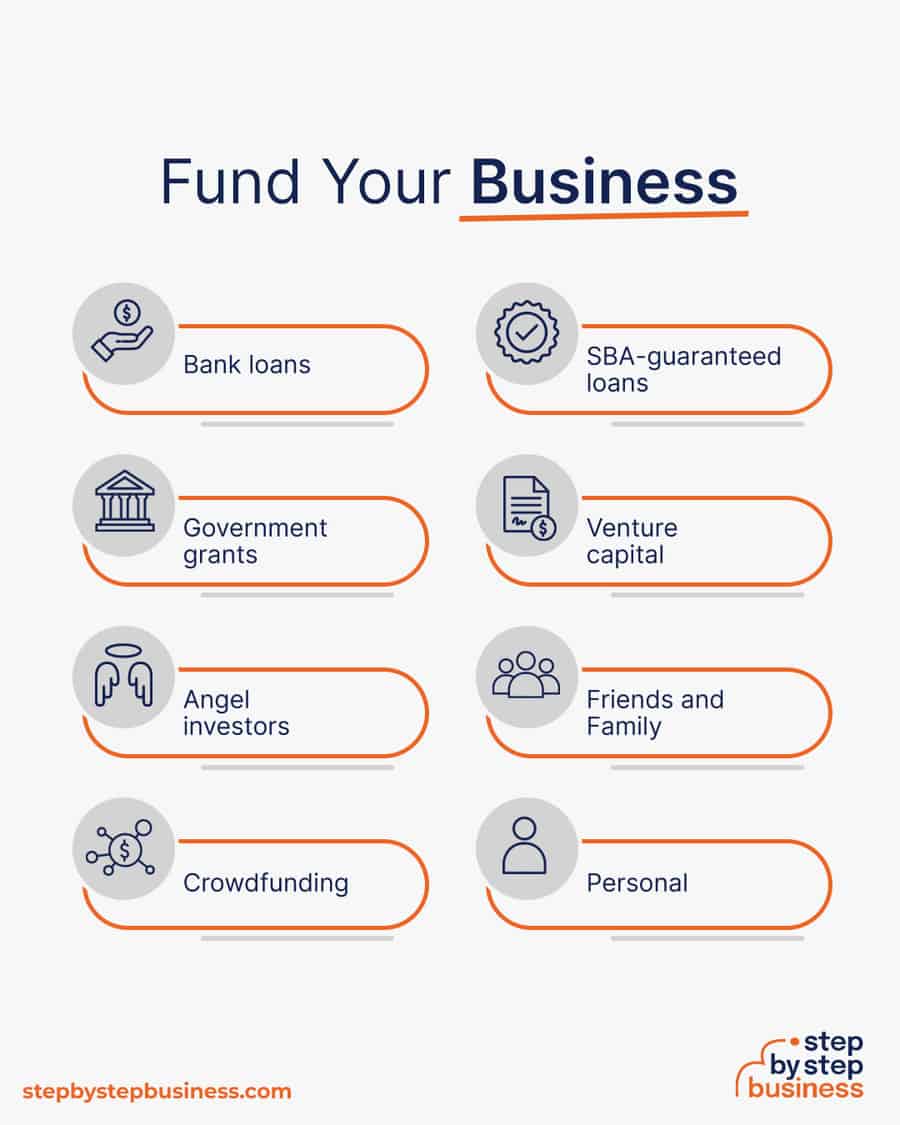
- Bank loans — This is the most common method but getting approved requires a rock-solid business plan and a strong credit history.
- SBA-guaranteed loans — The Small Business Administration can act as a guarantor, helping gain that elusive bank approval via an SBA-guaranteed loan .
- Government grants — A handful of financial assistance programs help fund entrepreneurs. Visit Grants.gov to learn which might work for you.
- Venture capital — Venture capital investors take an ownership stake in exchange for funds, so keep in mind that you’d be sacrificing some control over your business. This is generally only available for businesses with high growth potential.
- Angel investors — Reach out to your entire network in search of people interested in investing in early-stage startups in exchange for a stake. Established angel investors are always looking for good opportunities.
- Friends and family — Reach out to friends and family to provide a business loan or investment in your concept. It’s a good idea to have legal advice when doing so because SEC regulations apply.
- Personal — Self-fund your business via your savings or the sale of property or other assets.
Your best bet to finance a bank is to seek out angel investors or venture capital. You’ll have to have an extremely detailed business plan and pitch when seeking the considerable amount of money that you need.
Step 8: Apply for Bank Business Licenses and Permits
Starting a bank business requires obtaining a number of licenses and permits from local, state, and federal governments. You will need to apply for licenses and insurance with the Federal Reserve and the Federal Deposit Insurance Corporation (FDIC) .
Federal regulations, licenses, and permits associated with starting your business include doing business as (DBA), health licenses and permits from the Occupational Safety and Health Administration ( OSHA ), trademarks, copyrights, patents, and other intellectual properties, as well as industry-specific licenses and permits.
You may also need state-level and local county or city-based licenses and permits. The license requirements and how to obtain them vary, so check the websites of your state, city, and county governments or contact the appropriate person to learn more.
You could also check this SBA guide for your state’s requirements, but we recommend using MyCorporation’s Business License Compliance Package . They will research the exact forms you need for your business and state and provide them to ensure you’re fully compliant.
This is not a step to be taken lightly, as failing to comply with legal requirements can result in hefty penalties.
If you feel overwhelmed by this step or don’t know how to begin, it might be a good idea to hire a professional to help you check all the legal boxes.
Step 9: Open a Business Bank Account
Before you start making money, you’ll need a place to keep it, and that requires opening a bank account .
Keeping your business finances separate from your personal account makes it easy to file taxes and track your company’s income. Opening a business bank account is quite simple, and similar to opening a personal one. Most major banks offer accounts tailored for businesses — just inquire at your preferred bank to learn about their rates and features.
Banks vary in terms of offerings, so it’s a good idea to examine your options and select the best plan for you. Once you choose your bank, bring in your EIN, articles of incorporation, and other legal documents and open your new account.
Step 10: Get Business Insurance
Business insurance is an area that often gets overlooked yet it can be vital to your success as an entrepreneur. Insurance protects you from unexpected events that can have a devastating impact on your business.
Here are some types of insurance to consider:

- General liability — The most comprehensive type of insurance, acting as a catch-all for many business elements that require coverage. If you get just one kind of insurance, this is it. It even protects against bodily injury and property damage.
- Business property — Provides coverage for your equipment and supplies.
- Equipment breakdown insurance — Covers the cost of replacing or repairing equipment that has broken due to mechanical issues.
- Worker’s compensation — Provides compensation to employees injured on the job.
- Property — Covers your physical space, whether it is a cart, storefront, or office.
- Commercial auto — Protection for your company-owned vehicle.
- Professional liability — Protects against claims from clients who say they suffered a loss due to an error or omission in your work.
- Business owner’s policy (BOP) — This is an insurance plan that acts as an all-in-one insurance policy, a combination of the above insurance types.
You will also need FDIC insurance, and then you can use “member FDIC” in your marketing.
Step 11: Prepare to Launch
As opening day nears, prepare for launch by reviewing and improving some key elements of your business.
Essential Software and Tools
Being an entrepreneur often means wearing many hats, from marketing to sales to accounting, which can be overwhelming. Fortunately, many websites and digital tools are available to help simplify many business tasks.
You may want to use industry-specific software, such as Salesforce , FIS , or Alogent , to manage your operations, insurance, compliance, accounts, and financial processing.
- Popular web-based accounting programs for smaller businesses include Quickbooks , FreshBooks , and Xero .
- If you’re unfamiliar with basic accounting, you may want to hire a professional, especially as you begin. The consequences of filing incorrect tax documents can be harsh, so accuracy is crucial.
Develop Your Website
Website development is crucial because your site is your online presence and needs to convince prospective clients of your expertise and professionalism.
You can create your own website using website builders . This route is very affordable, but figuring out how to build a website can be time-consuming. If you lack tech savvy, you can hire a web designer or developer to create a custom website for your bank.
However, people are unlikely to find your website unless you follow Search Engine Optimization ( SEO ) practices. These are steps that help pages rank higher in the results of top search engines like Google.
Here are some powerful marketing strategies for your future bank:
- Local SEO — Regularly update your Google My Business and Yelp profiles to strengthen your local search presence.
- Social media financial education — Utilize platforms like LinkedIn to share financial insights and advice, establishing the bank as a thought leader.
- Digital advertising — Run targeted advertising campaigns for specific financial products and services to reach the right audience.
- Financial literacy campaigns — Distribute newsletters regularly with financial wellness tips and updates on banking products.
- Educational blog — Create content that provides guidance on financial trends, investment strategies, and saving tips.
- Webinars and live Q&As — Host online sessions that address customer financial concerns and recent market changes, enhancing engagement.
- Local sponsorships — Increase your community presence by sponsoring local events and sports teams.
- Financial workshops — Offer free financial planning workshops that cater to various life stages to educate and attract customers.
- Partnerships with local businesses — Collaborate with local businesses to offer banking benefits and host financial seminars.
- Personalized banking services — Provide tailored banking solutions based on customer data to enhance customer satisfaction.
- Rewards program — Develop a rewards program that incentivizes customers to use different banking services.
- Introductory offers — Launch promotions such as new account signup bonuses or reduced rates on loans for a limited time to attract new customers.
Focus on USPs

Unique selling propositions, or USPs, are the characteristics of a product or service that set it apart from the competition. Today, customers are inundated with buying options, so you’ll have a real advantage if they are able to quickly grasp how your bank meets their needs or wishes. It’s wise to do all you can to ensure your USPs stand out on your website and in your marketing and promotional materials, stimulating buyer desire.
Global pizza chain Domino’s is renowned for its USP: “Hot pizza in 30 minutes or less, guaranteed.” Signature USPs for your bank business could be:
- A welcoming community bank for all your financial needs
- Free checking accounts and the best loan rates in town
- Digital banking made easy
You may not like to network or use personal connections for business gain but your personal and professional networks likely offer considerable untapped business potential. Maybe that Facebook friend you met in college is now running a bank, or a LinkedIn contact of yours is connected to dozens of potential clients. Maybe your cousin or neighbor has been working in banks for years and can offer invaluable insight and industry connections.
The possibilities are endless, so it’s a good idea to review your personal and professional networks and reach out to those with possible links to or interest in banks. You’ll probably generate new customers or find companies with which you could establish a partnership.
Step 12: Build Your Team
If you’re starting out small from a home office, you may not need any employees. But as your business grows, you will likely need workers to fill various roles. Potential positions for a bank business include:
- Bank tellers — handling bank transactions
- Personal bankers — opening accounts, taking loan applications
- Mortgage originators — taking mortgage loan applications
- Bank manager — scheduling, managing branch operations
- Operations manager — managing back-office functions
- Compliance officer — handling regulatory compliance
At some point, you may need to hire all of these positions or simply a few, depending on the size and needs of your business. You might also hire multiple workers for a single role or a single worker for multiple roles, again depending on need.
Free-of-charge methods to recruit employees include posting ads on popular platforms such as LinkedIn, Facebook, or Jobs.com. You might also consider a premium recruitment option, such as advertising on Indeed , Glassdoor , or ZipRecruiter . Further, if you have the resources, you could consider hiring a recruitment agency to help you find talent.
Step 13: Run a Bank — Start Making Money!
Starting a bank takes time and money, and it’s a complicated business to run, but once you get it going, you can make a lot of money and serve your community. If you’re willing to do what it takes, you could even build your community bank into a national powerhouse!
Now that you understand what’s involved in the business, it’s time to find investors, get your bank up and running and start financing people’s dreams.
Leave a Reply Cancel reply
Your email address will not be published. Required fields are marked *
Save my name, email, and website in this browser for the next time I comment.
- Decide if the Business Is Right for You
- Hone Your Idea
- Brainstorm a Bank Name
- Create a Bank Business Plan
- Register Your Business
- Register for Taxes
- Fund Your Business
- Apply for Bank Business Licenses and Permits
- Open a Business Bank Account
- Get Business Insurance
- Prepare to Launch
- Build Your Team
- Run a Bank — Start Making Money!
Subscribe to Our Newsletter
Featured resources.
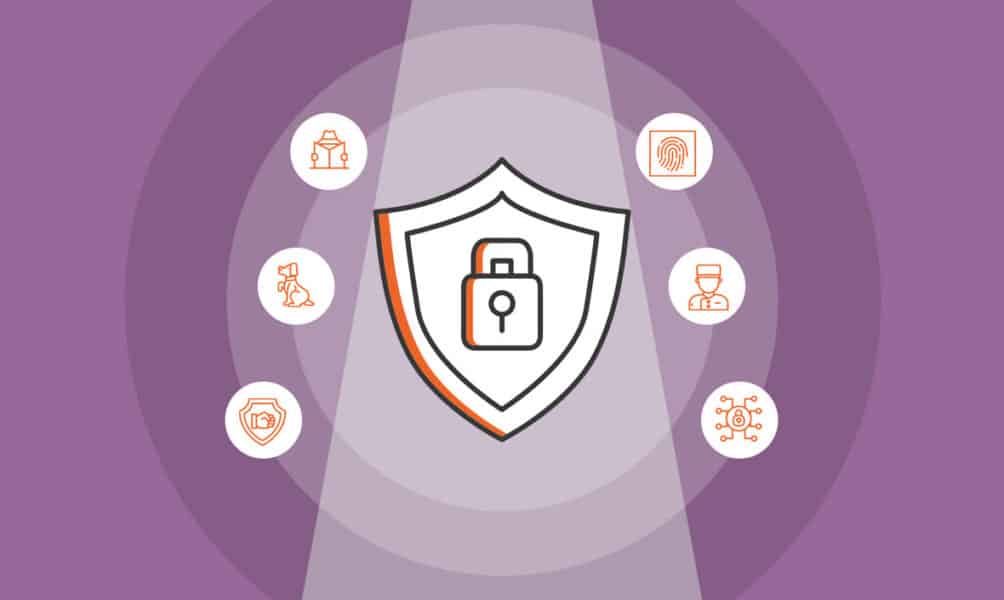
10 Unique Security Business Opportunities
David Lepeska
Published on November 4, 2022
The security services industry in the US is estimated to be worth $50 billion and expected to grow steadily in the next five years. Demand forsecuri ...
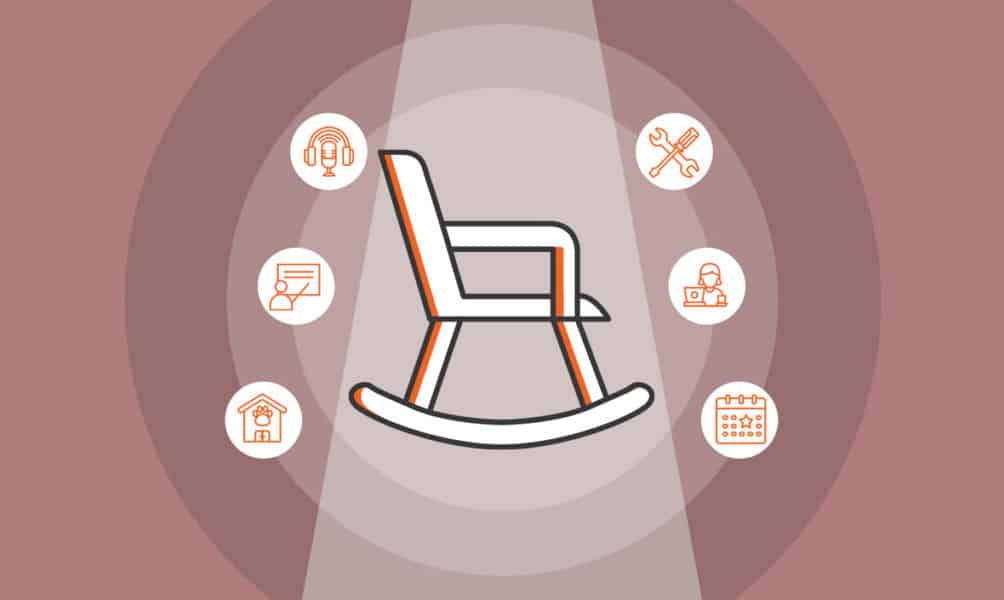
12 Retirement Business Ideas for a Fulfilling Second Career
Carolyn Young
Published on July 21, 2022
If you’re like many retirees these days, you’re not quite ready to slow down. You want to be productive and of real use. If you’re considering ...
No thanks, I don't want to stay up to date on industry trends and news.
How to Start a Bank: Complete Guide to Launch (2024)

It’s no surprise that one of the most profitable businesses around is banking. The United States alone has the world’s largest financial marketplace, and according to a report by SelectUSA, the financial services industry (which includes banks, investment services firms, and insurers) represents 7.4 percent, or $1.5 trillion, of the U.S. gross domestic product. For those who are willing and able to scale the significant barriers to entry, the rewards for opening a bank are great.
Regulations and capital are the two biggest hurdles to jump, and to be clear, starting a bank is not an easy endeavor, particularly for those unfamiliar with the industry. But with a solid, well-devised business plan and strategy, a pile of sweat equity, plentiful stores of patience, and a dash of good fortune, starting your own bank is possible.
Case Study: Bank of America
- Step 1: Know The Banking Industry
Step 2: Write a Business Plan
Step 3: raise capital, step 4: get a bank charter, step 5: apply for fdic approval, step 6: apply for other necessary permits, step 7: get customers.
Study the guide from start to finish, or click any of the links above to jump to the topic you need to know about right now.
Bank of America is a global giant with 66 million customers and operations in 35 countries worldwide. But like most multinational corporations, BoA’s story of success began with a single founder with a vision.
Bank of America actually started life as Bank of Italy (surprisingly enough) when Italian immigrant Amadeo Giannini founded the bank in San Francisco in 1904. Giannini’s objective was to offer banking services to other Italian immigrants and to middle-class Americans who were often denied accounts by the larger financial institutions of that time.
Providing banking for customers who didn’t already have it was the need that Giannini’s new bank met, and he quickly gained customers from all ethnic backgrounds. His clientele mirrored the “melting pot” of early 20th-century America, and so it was appropriate for him to rename his bank Bank of America.
He also had a bold vision that eventually became reality. Through mergers and acquisitions, Giannini’s humble bank became the U.S.’s largest bank and a global financial powerhouse in under a century. If you aspire to build such an impressive bank, start by learning to develop a business mindset.
Your startup bank may never reach BoA’s heights, but its story is proof that a broad, bold vision backed up with excellent customer service and exemplary corporate management can help a new bank transcend humble origins and become a dominant industry player.
You can write your own success story in banking by following these steps.
Step 1: Know the Banking Industry

Most of us are familiar with banking on some level, whether it be through checking and savings accounts, mortgages or loans, credit cards, retirement accounts, or insurance policies. But behind the ATM machine or the drive-thru window are a whole host of complicated transactions that, in aggregate, ensure that the bank not only has money for you to withdraw, but that as a business entity, it is making a profit.
If you haven’t worked in some level of the financial services industry, it’s important to get some industry experience, some specific education in finance, business, or both, and some expert guidance and advice.
How Much Money Do You Need to Start a Bank?
According to MergersCorp , bank startups need between $12 million and $20 million to start operations. Even if you have the money to start your own bank, you should expect it to take a year or more to become licensed and registered.
How Does a Bank Earn Revenue?
Very simply, banks make money by accepting customer deposits and providing financial services to their customers. Some of the financial services that banks offer include:
- Business loans: Loans to promising small business owners, including tech startups, health/wellness businesses, augmented reality technology, mobile apps, and e-learning platform entrepreneurs. Banks earn money based on the annual interest rate.
- Car loans: Many banks and credit unions provide car loans at better rates than dealerships and earn money on the interest.
- Mortgages: Banks make substantial money by lending funds to buy a home or investment property then collecting interest. They may also earn money by packaging loans together and selling them to other investors.
- Investment portfolio management: Experienced bankers may also offer financial investment portfolios for high net-worth individuals. They will normally charge service fees based on the amount of funds they manage for the customer.
- Credit cards: Banks may also offer credit cards to earn interest from the credit card fees. The interest will often be between 15% and 25%, which provides some of the highest returns in the financial services industry.
Banks also typically pay depositors interest on their deposits, ranging from .01% for most bank accounts to 5.15% for a certificate of deposit (CD).
The difference between the higher rates of interest charged to borrowers and the lower rates of interest paid to depositors is known as the interest spread, and this is the major component of bank profits.
Governments often incentivize loans to certain groups, like loans to women-owned businesses .
Is Owning a Bank Profitable?
Yes. Bank startup entrepreneurs will find a bank’s operations to be a very profitable business. According to NYU Stern , banks have nearly 100% gross profits and 30.89% net margins.
That makes a proposed bank nearly three times more profitable than the average business. But a bank’s operations are highly regulated. Read on to get an understanding of the agencies that you’ll have to work with as you learn how to start a bank.
How Much Does a Bank Owner Make?
According to CareerTrend , a president/owner of a small bank of less than 200 employees earns between $96,000 and $194,000 per year. This compensation is normally a combination of a base salary, profit-sharing, sales commissions, and bonuses.
Federal Reserve: Fractional Reserve Banking
The overwhelming majority of banks in the U.S. operate as fractional reserve banks. This means that at any given time, 10% of the bank’s deposits must be available for withdrawal.
This 10% of the deposit revenues is known as the fractional reserve. For instance, for every $100 that a customer deposits, the bank may use $90 to lend out to other customers (including you, for that matter).
Low fractional reserves allow the circulation of money throughout the economy as measured by a factor called the economic multiplier. Fractional reserves increase the monetary supply for borrowers and are seen as instruments to maintain prosperity and a healthy national economy.
In fact, to maintain a healthy economy in response to the coronavirus pandemic, the Federal Reserve took the unprecedented step to reduce the fractional reserve requirement to zero on March 26, 2020.
The concept of fractional reserve means that banks are counting on depositors holding the majority of their funds in their accounts and not withdrawing them all at once.
Most of the time, that is what happens. But when depositors start to withdraw from their accounts in response to a financial crisis or panic, this is known as a bank run , and it can cause the bank to become insolvent and go out of business.

Federal Deposit Insurance Corporation (FDIC)

The Banking Act of 1933 created the Federal Deposit Insurance Corporation ( FDIC ), which is the regulator for the U.S. banking industry, and it guarantees consumers’ checking and savings accounts up to $250,000 in the event of bank insolvency.
The FDIC is also the regulatory agency for all banks in the United States, and their website provides information and the necessary forms that de novo, or newly established, banks must submit.
Once your bank’s application is in place, expect to wait anywhere from one year to 18 months for approval.
Banks spread out their risk of bank runs by accumulating large numbers of depositors. Low or non-existent fractional reserve requirements have fueled the growth of large national or multinational banks.
Since 2000, there have been 569 bank closures with assets of $1.276 trillion according to the FDIC , which insured nearly 70% of the losses .
Most of these were during the Great Recession caused by the subprime mortgage crisis in 2008, but an average of four banks close each year due to lack of capital adequacy, buyouts, and other causes.
Online Banks
Online banks are typically newly established banks that use emerging technologies to provide a bank account that offers unique features like higher interest payments, buckets for finances, or artificial intelligence technology to help manage finances better.
De Novo Banks
During the first five years of a bank’s operations, you may also hear it referred to as de novo banks, from the Latin word for “new.”
In addition to being up against the economy of scale advantages that large banks enjoy, there are a couple of significant barriers to entry that new bank entrepreneurs must scale. These are 1) regulation, and 2) capitalization (more on this below).
Banking is the most regulated business in the United States. According to Independent Banker , an average of 172 de novo banks opened each year before the 2008 financial crisis.
Since that watershed year, the number dwindled to almost nothing. A significant reason for this downturn is the increased regulations that banks must comply with to even open for business.
Can I Start a Bank With No Money?
Bank founders will have to get a substantial amount of money to set up risk management infrastructure, obtain approval, get their banking license, and comply with banking regulations. This business idea requires a large source of capital from either your own personal wealth, venture capitalists, or other business owners.
If you don’t know where you would get $20 million dollars, consider another business idea .
Get Business Ideas in the UpFlip Academy
We’ve interviewed hundreds of business owners and compiled more than 500 business ideas. We’ve turned them into a database that you can sort by startup costs, average revenue profit margins, time to start the business, and market size.

Banking business plans require careful planning to comply with the complex process of working with appropriate authorities that oversee the management of the banking system.
Your business plan is your venture’s founding document and will be the reference point for all business decisions moving forward. For this reason, it’s important to spend time writing the business plan.
Luckily, there are numerous business planning resources including:
- Small Business Association (SBA): Learn about business plans directly from the government agency that was created to help businesses succeed.
- Bank of America: Read the BoA guide to writing a business plan .
- Chron : Review a step-by-step guide to writing a business plan for a bank.
- BMA Banking Systems : Read the comprehensive guide to writing a plan for a de novo bank.
When you apply for FDIC approval and insurance, they will examine your business plan closely to make sure you will meet regulations and follow banking industry best practices.
We’ll discuss the elements of a good banking business plan in the next sections.
Explain How Your Own Bank Will Make Money
We’ve discussed the primary ways banks make money. You’ll need to explain what services your legal entity will offer and how you’ll comply with the regulatory process.
Plus, you’ll need to ensure regulatory authorities that you’ll manage potential customers’ money in a safe and sound manner.
Identify Your Target Market
Bank startup ideas will have a different target market based on the location, business model, and scope of business.
For instance, if you’re targeting a younger generation of customers, you’ll need to have a big online presence and mobile banking capability.
If you’re targeting older customers, perhaps retirees, mobile banking may be less of a consideration, but convenient branch locations with easy access and plentiful parking become critical.
Another consideration is whether you want to target small business firms by offering business banking, or whether you want to focus more, or solely, on consumer banking.
It can be hard to accurately describe your market, but it’s a critical assessment to make. Market research firms can gather data that either confirm or deny your own intuitions and can help prevent you from making poor decisions early on. For these reasons, it’s worth considering hiring one.
You can find a guide to market research for new businesses from Entrepreneur . And Joe Gardner, CEO of VentureDevs , has a complete guide to market research published by Forbes .
Document the Type of Bank
There are a ton of different types of banks, and you’ll have to decide which one you’re going to create. Some of the options are:
- National Bank: These are similar to the legacy banks like Bank of America and Wells Fargo that have a business location in the majority of states.
- State Chartered Bank : These banks are approved to operate in a single state.
- Online Banks : Companies like Ally and Chime create an online platform to provide banking and financial services. Learn about online banks .
- Credit Unions: These banks are member-owned banks that pay dividends to their account holders.
Most banks are a combination of brick-and-mortar branches with an online banking counterpart, but the extent to which each element is promoted depends on the banking habits of your customer base.
Online-only banks save on infrastructure costs, but when starting your online bank, don’t forget to consider the enhanced cybersecurity costs you’ll incur.
And if you think that by opening a bank as an online-only business you’ll escape the regulatory scrutiny that brick-and-mortar banks endure, think again. The same charter and regulatory code that storefront banks operate under also applies to online banks.
In addition to these laws, you’ll also have to comply with other regulations designed specifically for online banking. These regulations were devised by an organization called the Federal Financial Institutions Examination Council (FFIEC) and are listed in this guide to online banking .
Define Your Business Structure
Your bank startup costs will be underwritten by a team of investors. That means a corporation is the prevailing business structure in the banking industry.
You’ll need to register with your state’s corporation commission or board, but beyond this, you’ll need to consider how the initial board of directors is chosen, what their terms of engagement will be, their compensation (if any), and how often they will meet (your state may mandate a minimum number of yearly meetings).
You should hire a law firm to form your corporation because it’s easier to head off any problems as the business is formed than it is to go back and change your founding documents or business protocols once issues arise.
Most of this process will be done through the Secretary of State Office in the state your bank will be based in. You’ll also have to look at how to open your own bank in each state where you’ll be operating.
Choose Your Bank Business Name

Your bank name can reflect your geographic origins, or it can be more abstract, or even the name of one of its founders. An example of the former is Bank of America, and an example of the latter is Chase.
Choosing your bank name is an important consideration that can affect both the present and future of financial institutions.
For example, naming your bank Bank of North Carolina may attract customers in your home state who want to do business with local financial institutions, but it could hinder your expansion if you want to open branches in, say, Florida. Choose wisely.
Check out our guide to choosing a business name . You might also look at Forbes’ guide, or The Balance. Shopify even has a tool that will generate a business name and claim the domain for you.
Once you’ve determined your bank name, run searches on your state corporation’s website and also do a WHOIS domain name search via a service like ICANN . The latter is critically important for online banking because having your bank name and website different can be devastating for business.
ICANN can also tell you if somebody currently owns the domain name you’re after and what they will charge to sell it to your business.
Address Start-Up and Operations Costs
Your plan should outline the source(s) of your capital and how and when your investors will be paid back. Your operations costs must also be carefully outlined, and the FDIC will look at your plan to ensure that operations costs are realistic and not underestimated. When calculating your answer to the question How much does it cost to start a bank? , include these for main costs.
1. Regulatory/Legal Compliance
Almost all established banks have attorneys on staff to assist with legal and regulatory compliance, and even as a de novo bank, you should enlist the services of a lawyer.
The fines for non-compliance can be severe and far exceed legal fees. Non-compliance can also place the bank’s future in jeopardy.
2. KYC And AML Compliance
KYC (Know Your Customer) and AML (Anti Money Laundering) regulations exist to make sure that banks are doing business with legitimate entities and not criminal organizations.
In essence, AML mandates KYC, which is verified by having account holders submit documentation before opening accounts.
KYC and AML protect banks from criminal liability, but adherence to these regulations isn’t cheap.
A key part of starting any financial institution is ensuring you have proper procedures set up to meet KYC and AML compliance obligations,
says Greg Pinn, Sr. Director of Merlon , which produces automated systems for regulation compliance.
He also explains that
Banks can spend as much as 2.5% of their operating expenses on AML compliance, a huge expense for any bank starting out. Setting up these programs correctly can reduce that expense by a significant amount.
KYC3 has a helpful guide to understanding KYC and AML compliance and their implications for startup banks.
3. Security

A brick-and-mortar bank branch needs a secure vault, security protocols for armored car cash deliveries, electronic security systems for the building, and sometimes armed guards on site.
Given these costly measures, it might seem like online banks have it easier in terms of security costs.
This isn’t necessarily the case, however: A 2023 report conducted by IBM found that a cybersecurity incident costs a bank $5.9 million on average.
The American Bankers Association has some information about cybersecurity risks and some helpful links to resources for cybersecurity for small businesses in general and banks in particular.
No bank can be a sole proprietorship. Even a small bank requires a minimum of 10 employees, and most banks have more than 20 full-time employees working for them. Among the types of employees banks require are:
- Bank managers
- Bank tellers
- Loan salespeople
- Personal bankers
- Investment consultants
- Accountants
Beyond the operations staff you’ll need for day-to-day operations, you’ll need to carefully select a management team of individuals that includes women and minority representation. This management team will be carefully scrutinized by the FDIC during the approval process, and all members should share vast knowledge and experience in the banking and financial services industry.
Hiring competent and experienced staff who share your vision is a critical step to take, and one that requires significant thought, time, and energy.
Chinese business magnate Jack Ma writes,
You’ve got to make your team have value, innovation, and vision.
McKinsey and Company , as well as the American Bankers Association, both offer helpful guidelines for selecting your management team and employees.

After you’ve gained adequate knowledge and experience and a solid plan for your business has been developed and written down, it’s time to start putting the pieces together.
The hardest step is usually coming up with the capital that the FDIC requires.
As is the case for most businesses, adequate capital can keep a bank afloat during crises and hard times, and somewhere between $20 and $40 million dollars of capitalization is normally required just to get out of the gate and start doing business. When it comes down to it, more is better.
Most individual entrepreneurs don’t have access to this kind of capital, so you’re going to need to build a team of investors.
If you’ve had a career working for another bank, you may know colleagues who have expressed an interest in starting their own bank, so reach out to these people (but also be aware of non-competitive clauses in their current employment contracts. The Federal Trade Commission recently nullified most non-competes , but executives may still be constrained by such clauses).
Read on for more ideas on individuals to pursue as you work to get your bank off the ground.
Community Leaders
If your bank will be serving a particular community, business, or industry, reach out to community leaders and business owners.
If you know these leaders from your previous career working for an established bank, they will be more willing to work with you because they know your personal qualities, integrity, and excellent reputation.
Community leaders in particular may be interested in creating a bank that is headquartered locally and that serves local customers specifically.
Even in the 21st century, this sort of provincialism can attract new account holders and drives customer loyalty.
But if these sources of investors don’t yield the capital that you’ll need for your new bank, you’re going to have to approach venture capitalists.
Venture Capitalists
The banking industry is a relatively low-risk investment for venture capitalists because of its regulatory climate. They’ll want long term profit shares though. Given banking profits are high, you won’t be in poverty while paying back venture capitalists. For an excellent overview of how venture capitalists work, read this article from the Harvard Business Review. Oracle NetSuite also offers a comprehensive guide to attracting venture capitalists that includes a downloadable e-book.
According to the Federal Reserve , a de novo bank must operate under either a federal or state charter. A charter is a legal document that authorizes the bank to conduct business.
A charter includes the bank’s articles of incorporation and certificate of incorporation, which is usually issued by the state corporation commission.
Charters can be issued at the federal level by the Office of the Comptroller of the Currency ( OCC ), or by the state (or the District of Columbia, Guam, Puerto Rico, or the Virgin Islands) in which the bank is incorporated, usually through its banking commission.
As with the FDIC application, federal and state charter offices will carefully evaluate the bank’s business plan, executive team, board of directors, and capitalization amount.
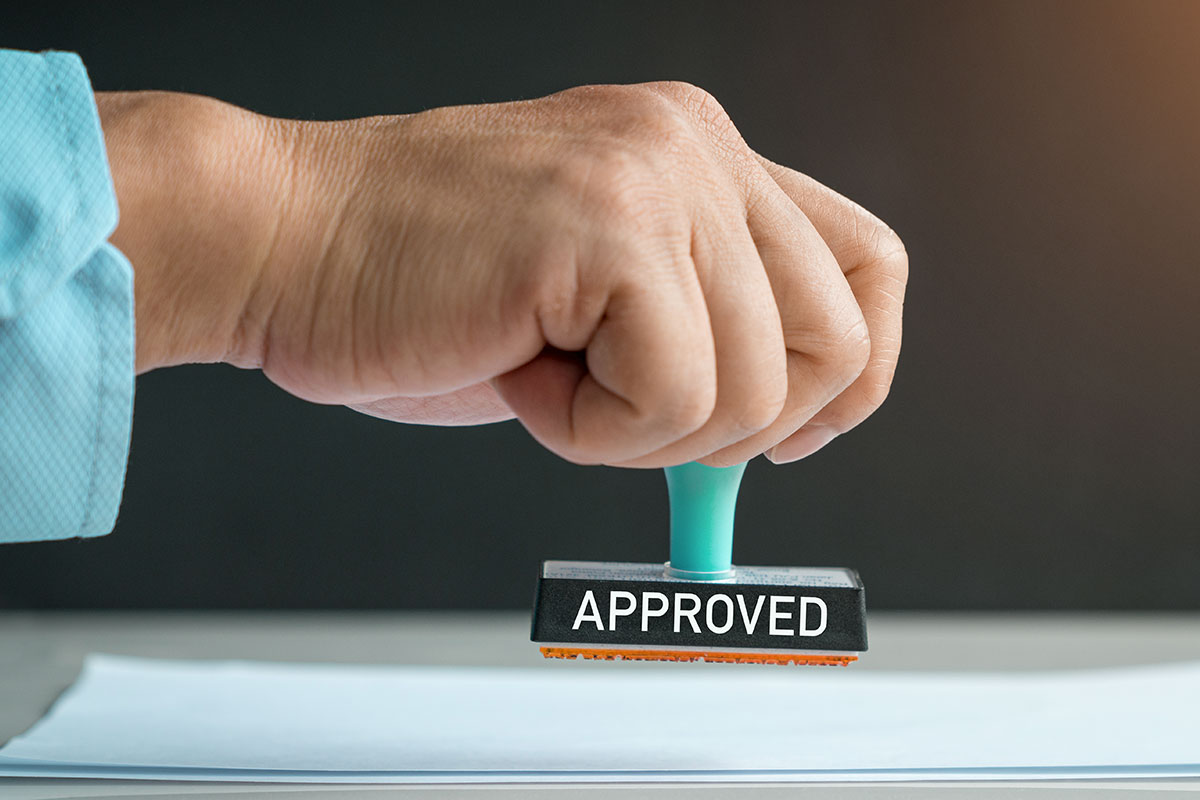
The Federal Deposit Insurance Corporation (FDIC) evaluates, and, upon approval, insures and sanctions every new bank in the United States. Required elements of the application and necessary forms are available on the FDIC website . These are the necessary elements:
- Mission statement
- Business plan
- Financial projections for a minimum of three years
- Policy descriptions for loans, investments, and insurance
Obtaining both the bank charter and FDIC approval takes some time—a minimum of 12 months and sometimes as long as 24 months. While you are waiting for approval to come through, you can continue to work on opening your bank.
| The UpFlip Academy is your one-stop destination for premium business programs that show you exactly how to build a profit-making machine. Follow along with real, successful business owners like Brandon Vaughn and Brianna Rooney who are making millions every year. They break down how to start a successful biz and all the factors to take into consideration. With useful workshops and interactive experiences within the community, you can start planning your next venture. | |
Most bank charters are a sanction for the bank to conduct business, but there may be additional permits or local zoning laws to comply with. The Small Business Association’s website offers easy ways to check for required state and local licenses and permits for your business:
- State : You’ll need to visit your state’s website for specific information on which permits you’ll need to start a bank there. Almost all states will require a charter, and even if it is a national charter, you’ll likely have to apply for a license through the state agency that issues bank charters. If you have some flexibility as you decide where to locate your new bank, you can visit the SBA’s Pick your business location page , which gives some helpful tips on how to choose where to locate your business.
- Local : Again, localities vary widely when it comes to the number of regulations that all new businesses, and especially banks, require. The general rule of thumb is that the larger the population and the amount of businesses in your location, the more permits and paperwork are required. If you have a local SBA office, visit them for advice and assistance.
If you are opening a brick-and-mortar bank, you’ll often need to acquire a Certificate of Occupancy. The CO certifies that all local zoning laws and building codes have been followed.
If you are renting a building, the landlord is usually responsible for the CO.

With all the regulatory compliance that starting a bank involves, it’s easy to lose sight of the end goal of any business: attracting and retaining new customers.
Getting customers through your new bank’s doors (or to its website) requires differentiating yourself from your competition.
Create Your Brand
One of the best ways to draw in new customers is by crafting a memorable brand image that you can apply across platforms. This will involve putting together an effective branding campaign that clearly communicates your bank’s mission, values, and identity.
Get a Good Logo

Successful branding begins with a bank logo that represents the company effectively and in a simple, easily memorable manner.
If designing isn’t your strength, many firms offer logo design services at reasonable rates. Investing in a good logo is a step toward a bright future for your new bank.
Advertise Your Brand
Successful advertising happens via both traditional and social media.
The correct answer to Which media platforms should you use to advertise? is All of them . But the target audience that you defined in your business plan will dictate which print, digital, and social media platforms you focus your advertising budget on.
Gain a Social Media Presence

Younger consumers will tend to favor social media. Ellen McGovern, chief marketing officer at Massachusetts-based Clinton Savings Bank, explains the need to be on social media to attract and retain younger customers in an article published by American Banker :
Many financial institutions have what the industry refers to as an aging customer base. We need to continue to develop ways to attract this younger demographic.
One of the most effective networks of promotion for this younger generation of customers is social media influencers.
In the same article, Molly Young, product marketing manager at partnership automation company Impact , explains the marketing power of influencers:
Banking and finances can sometimes be opaque to would-be participants. By sharing their experiences, modeling their usage, and infusing a brand’s message with their own relatability, influencers can break down barriers.
Don’t Neglect Traditional Forms of Advertising
If the newer generation of bank customers prefers the influencer network, then older consumers choose traditional media like newspapers and TV, and you certainly can’t afford to alienate this important market segment. So a full portfolio of a combination of new and traditional media is in order.
The best way to determine which media will reach your targeted audience is to request a media kit from prominent local media outlets.
The best media kits will offer detailed audience information that will allow you to select those outlets whose audience most closely matches your target consumer base.
Determine Your Competitive Advantage
Branding and advertising can all be for naught if your bank’s competitive advantage is not clearly defined. A competitive advantage is a unique service, perk, or reward that differentiates your business from others.
Banking is a very competitive industry with large players that have thousands of branches across the country and an economy of scale that allows large banks to waive many fees and offer higher interest yields on checking and savings accounts.
If you can’t match the large banks on price, then perhaps your small, community-based bank can offer personalized, custom accounts to meet individual consumers’ needs, or offer free financial literacy classes for their account holders.
Links to Resources About Business Marketing
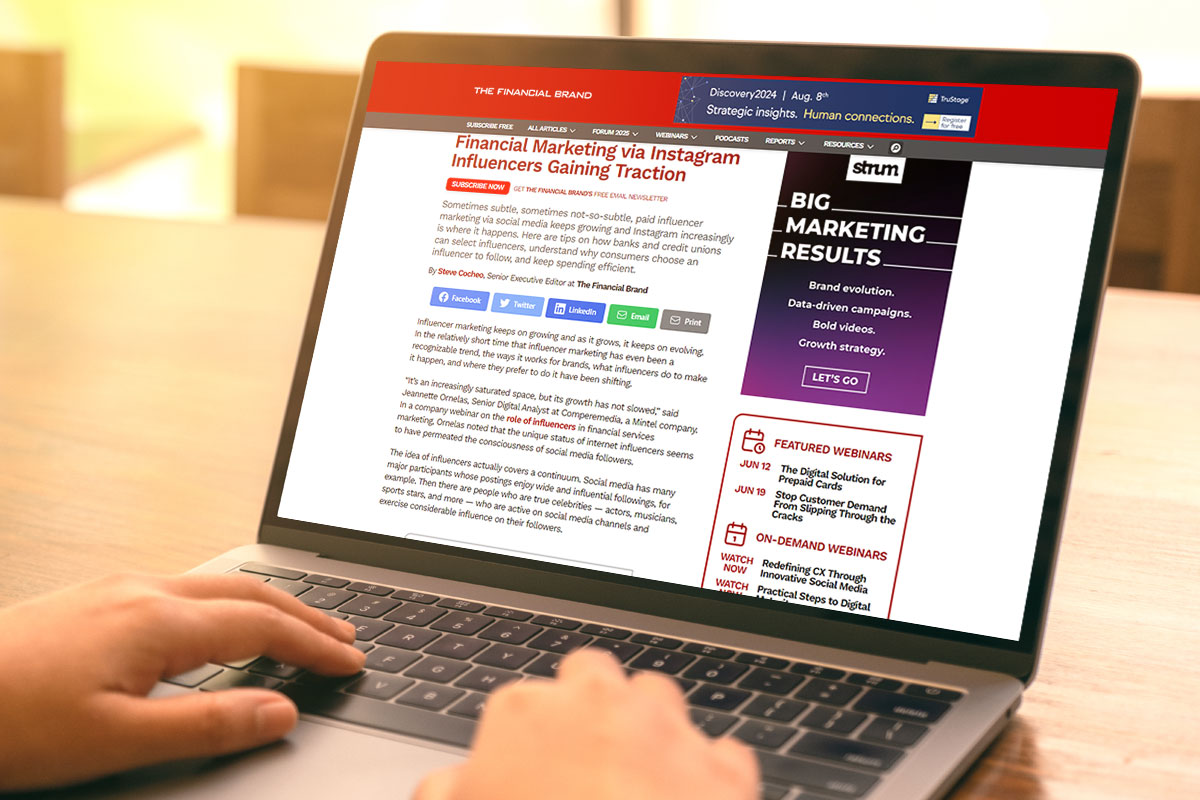
Several other articles could be written about marketing, advertising, and PR for your new bank, but there are a couple of excellent already-published articles that focus specifically on getting customers.
- Forbes offers 10 ways to get customers to your new small business
- Inc. offers the same, with a focus on increasing your sales
For a good primer on using influencer marketing, check out this article from The Financial Brand .
Once you have customers, the competition in the financial industry means that pleasing and keeping your base of customers is also essential for success.
Jim Marous, co-publisher of The Financial Brand says,
Bottom line, having a customer-centric culture is more than just a good thing—it’s become a matter of survival.
Business and Fintech Influencers to Follow on Social Media:
- Sebastien Meunier ( Twitter , LinkedIn )
- Bradley Leimer ( Twitter , LinkedIn )
- Brett King ( Twitter LinkedIn )
Video Resources
- Khan Academy’s Intro to Banking
- Building a Bank by MIT Bootcamps
- Banking Explained from Money and Credit
- How to Write a Business Plan by the Young Entrepreneurs Forum
- How to Build a Business from Project Better Self
Starting a bank takes a lot of know-how, plenty of industry experience, and loads of patience and determination to get through the charter and FDIC approval processes. Plus, you’ll need a huge amount of capital.
For these reasons, we can’t recommend starting a bank as your first entrepreneurial venture, but more as a capstone if you’ve had a successful career in banking and financial services.
For those who successfully scale the formidable barriers to entry, the financial rewards can be great. But for many community bank owners, the real reward is in providing an essential institution that ensures the financial well-being of their community.
British business titan Sir Richard Branson sums up the essential purpose of any business: “A business is simply an idea to make other people’s lives better,” and your bank could do just that.
80% of businesses fail... Learn how not to.
Learn from business failures and successes in 5 min or less. The stories, frameworks, and tactics that will make you a 10x better founder.
Brandon Boushy
Related articles
664 Painting Business Names (2024)
Vending Machine Business Plan: The Ultimate Guide
S-Corp vs LLC: Which is Right for My Business?
yes please i would love to learn more on this aspect
Banking business
Great article. The world of banking is an interesting one. Not just from an income standpoint, I believe the correct banking setup can help improve customers' lives as well.
I will like to join the discussion
I love the discussion and will like to continue with it because, it's very much crucial. It's lucrative for me to know more about it and thank you very much for enlighten me.
Great advice, about to start my first bank! Do you have any suggestions for the name? Thank you
Become a business owner in less than 90 days
Start your 10-day free trial of the UpFlip Academy and learn how to start your own business from scratch.
Get business advice straight to your Inbox

Bank Business Plan Template
Written by Dave Lavinsky

Bank Business Plan
Over the past 20+ years, we have helped over 500 entrepreneurs and business owners create business plans to start and grow their banks.
If you’re unfamiliar with creating a bank business plan, you may think creating one will be a time-consuming and frustrating process. For most entrepreneurs it is, but for you, it won’t be since we’re here to help. We have the experience, resources, and knowledge to help you create a great business plan.
In this article, you will learn some background information on why business planning is important. Then, you will learn how to write a bank business plan step-by-step so you can create your plan today.
Download our Ultimate Business Plan Template here >
What Is a Bank Business Plan?
A business plan provides a snapshot of your bank as it stands today, and lays out your growth plan for the next five years. It explains your business goals and your strategies for reaching them. It also includes market research to support your plans.
Why You Need a Business Plan for Your Bank Business
If you’re looking to start a bank or grow your existing bank, you need a business plan. A business plan will help you raise funding, if needed, and plan out the growth of your bank to improve your chances of success. Your bank business plan is a living document that should be updated annually as your company grows and changes.
Sources of Funding for Banks
With regards to funding, the main sources of funding for a bank are personal savings, credit cards, bank loans, and angel investors. When it comes to bank loans, banks will want to review your business plan and gain confidence that you will be able to repay your loan and interest. To acquire this confidence, the loan officer will not only want to ensure that your financials are reasonable, but they will also want to see a professional plan. Such a plan will give them the confidence that you can successfully and professionally operate a business. Personal savings and bank loans are the most common funding paths for banks.
Finish Your Business Plan Today!
How to Write a Business Plan for a Bank
If you want to start a bank or expand your current one, you need a business plan. The guide below details the necessary information for how to write each essential component of your bank business plan.
Executive Summary
Your executive summary provides an introduction to your business plan, but it is normally the last section you write because it provides a summary of each key section of your plan.
The goal of your executive summary is to quickly engage the reader. Explain to them the kind of bank you are running and the status. For example, are you a startup, do you have a bank that you would like to grow, or are you operating a chain of banks?
Next, provide an overview of each of the subsequent sections of your plan.
- Give a brief overview of the bank industry.
- Discuss the type of bank you are operating.
- Detail your direct competitors. Give an overview of your target customers.
- Provide a snapshot of your marketing strategy. Identify the key members of your team.
- Offer an overview of your financial plan.
Company Overview
In your company overview, you will detail the type of bank you are operating.
For example, you might specialize in one of the following types of banks:
- Commercial bank : this type of bank tends to concentrate on supporting businesses. Both large corporations and small businesses can turn to commercial banks if they need to open a checking or savings account, borrow money, obtain access to credit or transfer funds to companies in foreign markets.
- Credit union: this type of bank operates much like a traditional bank (issues loans, provides checking and savings accounts, etc.) but banks are for-profit whereas credit unions are not. Credit unions fall under the direction of their own members. They tend to serve people affiliated with a particular group, such as people living in the same area, low-income members of a community or armed service members. They also tend to charge lower fees and offer lower loan rates.
- Retail bank: retail banks can be traditional, brick-and-mortar brands that customers can access in-person, online, or through their mobile phones. They also offer public financial products and services such as bank accounts, loans, credit cards, and insurance.
- Investment bank: this type of bank manages the trading of stocks, bonds, and other securities between companies and investors. They also advise individuals and corporations who need financial guidance, reorganize companies through mergers and acquisitions, manage investment portfolios or raise money for certain businesses and the federal government.
In addition to explaining the type of bank you will operate, the company overview needs to provide background on the business.
Include answers to questions such as:
- When and why did you start the business?
- What milestones have you achieved to date? Milestones could include the number of clients served, the number of clients with positive reviews, reaching X number of clients served, etc.
- Your legal business Are you incorporated as an S-Corp? An LLC? A sole proprietorship? Explain your legal structure here.
Industry Analysis
In your industry or market analysis, you need to provide an overview of the bank industry.
While this may seem unnecessary, it serves multiple purposes.
First, researching the bank industry educates you. It helps you understand the market in which you are operating.
Secondly, market research can improve your marketing strategy, particularly if your analysis identifies market trends.
The third reason is to prove to readers that you are an expert in your industry. By conducting the research and presenting it in your plan, you achieve just that.
The following questions should be answered in the industry analysis section of your bank business plan:
- How big is the bank industry (in dollars)?
- Is the market declining or increasing?
- Who are the key competitors in the market?
- Who are the key suppliers in the market?
- What trends are affecting the industry?
- What is the industry’s growth forecast over the next 5 – 10 years?
- What is the relevant market size? That is, how big is the potential target market for your bank? You can extrapolate such a figure by assessing the size of the market in the entire country and then applying that figure to your local population.
Customer Analysis
The customer analysis section of your bank business plan must detail the customers you serve and/or expect to serve.
The following are examples of customer segments: individuals, small businesses, families, and corporations.
As you can imagine, the customer segment(s) you choose will have a great impact on the type of bank you operate. Clearly, corporations would respond to different marketing promotions than individuals, for example.
Try to break out your target customers in terms of their demographic and psychographic profiles. With regards to demographics, including a discussion of the ages, genders, locations, and income levels of the potential customers you seek to serve.
Psychographic profiles explain the wants and needs of your target customers. The more you can recognize and define these needs, the better you will do in attracting and retaining your customers.
Finish Your Bank Business Plan in 1 Day!
Don’t you wish there was a faster, easier way to finish your business plan?
With Growthink’s Ultimate Business Plan Template you can finish your plan in just 8 hours or less!
Competitive Analysis
Your competitive analysis should identify the indirect and direct competitors your business faces and then focus on the latter.
Direct competitors are other banks.
Indirect competitors are other options that customers have to purchase from that aren’t directly competing with your product or service. This includes trust accounts, investment companies, or the stock market. You need to mention such competition as well.
For each such competitor, provide an overview of their business and document their strengths and weaknesses. Unless you once worked at your competitors’ businesses, it will be impossible to know everything about them. But you should be able to find out key things about them such as
- What types of customers do they serve?
- What type of bank are they?
- What is their pricing (premium, low, etc.)?
- What are they good at?
- What are their weaknesses?
With regards to the last two questions, think about your answers from the customers’ perspective. And don’t be afraid to ask your competitors’ customers what they like most and least about them.
The final part of your competitive analysis section is to document your areas of competitive advantage. For example:
- Will you provide loans and retirement savings accounts?
- Will you offer products or services that your competition doesn’t?
- Will you provide better customer service?
- Will you offer better pricing?
Think about ways you will outperform your competition and document them in this section of your plan.
Marketing Plan
Traditionally, a marketing plan includes the four P’s: Product, Price, Place, and Promotion. For a bank business plan, your marketing strategy should include the following:
Product : In the product section, you should reiterate the type of bank company that you documented in your company overview. Then, detail the specific products or services you will be offering. For example, will you provide savings accounts, auto loans, mortgage loans, or financial advice?
Price : Document the prices you will offer and how they compare to your competitors. Essentially in the product and price sub-sections of your plan, you are presenting the products and/or services you offer and their prices.
Place : Place refers to the site of your bank. Document where your company is situated and mention how the site will impact your success. For example, is your bank located in a busy retail district, a business district, a standalone office, or purely online? Discuss how your site might be the ideal location for your customers.
Promotions : The final part of your bank marketing plan is where you will document how you will drive potential customers to your location(s). The following are some promotional methods you might consider:
- Advertise in local papers, radio stations and/or magazines
- Reach out to websites
- Distribute flyers
- Engage in email marketing
- Advertise on social media platforms
- Improve the SEO (search engine optimization) on your website for targeted keywords
Operations Plan
While the earlier sections of your business plan explained your goals, your operations plan describes how you will meet them. Your operations plan should have two distinct sections as follows.
Everyday short-term processes include all of the tasks involved in running your bank, including reconciling accounts, customer service, accounting, etc.
Long-term goals are the milestones you hope to achieve. These could include the dates when you expect to sign up your Xth customer, or when you hope to reach $X in revenue. It could also be when you expect to expand your bank to a new city.
Management Team
To demonstrate your bank’s potential to succeed, a strong management team is essential. Highlight your key players’ backgrounds, emphasizing those skills and experiences that prove their ability to grow a company.
Ideally, you and/or your team members have direct experience in managing banks. If so, highlight this experience and expertise. But also highlight any experience that you think will help your business succeed.
If your team is lacking, consider assembling an advisory board. An advisory board would include 2 to 8 individuals who would act as mentors to your business. They would help answer questions and provide strategic guidance. If needed, look for advisory board members with experience in managing a bank or successfully running a small financial advisory firm.
Financial Plan
Your financial plan should include your 5-year financial statement broken out both monthly or quarterly for the first year and then annually. Your financial statements include your income statement, balance sheet, and cash flow statements.
Income Statement
An income statement is more commonly called a Profit and Loss statement or P&L. It shows your revenue and then subtracts your costs to show whether you turned a profit or not.
In developing your income statement, you need to devise assumptions. For example, will you see 5 clients per day, and/or offer sign up bonuses? And will sales grow by 2% or 10% per year? As you can imagine, your choice of assumptions will greatly impact the financial forecasts for your business. As much as possible, conduct research to try to root your assumptions in reality.
Balance Sheets
Balance sheets show your assets and liabilities. While balance sheets can include much information, try to simplify them to the key items you need to know about. For instance, if you spend $50,000 on building out your bank, this will not give you immediate profits. Rather it is an asset that will hopefully help you generate profits for years to come. Likewise, if a lender writes you a check for $50,000, you don’t need to pay it back immediately. Rather, that is a liability you will pay back over time.
Cash Flow Statement
Your cash flow statement will help determine how much money you need to start or grow your business, and ensure you never run out of money. What most entrepreneurs and business owners don’t realize is that you can turn a profit but run out of money and go bankrupt.
When creating your Income Statement and Balance Sheets be sure to include several of the key costs needed in starting or growing a bank:
- Cost of furniture and office supplies
- Payroll or salaries paid to staff
- Business insurance
- Other start-up expenses (if you’re a new business) like legal expenses, permits, computer software, and equipment
Attach your full financial projections in the appendix of your plan along with any supporting documents that make your plan more compelling. For example, you might include your bank location lease or a list of accounts and loans you plan to offer.
Writing a business plan for your bank is a worthwhile endeavor. If you follow the template above, by the time you are done, you will truly be an expert. You will understand the bank industry, your competition, and your customers. You will develop a marketing strategy and will understand what it takes to launch and grow a successful bank.
Don’t you wish there was a faster, easier way to finish your Bank business plan?
OR, Let Us Develop Your Plan For You
Since 1999, Growthink has developed business plans for thousands of companies who have gone on to achieve tremendous success. See how a Growthink business plan consultant can create your business plan for you.
Other Helpful Business Plan Articles & Templates

- Business Ideas
- Registered Agents
How to Start a Bank in 14 Steps (In-Depth Guide)
Updated: January 18, 2024
BusinessGuru.co is reader-supported. When you buy through links on my site, we may earn an affiliate commission. Learn more
The banking industry is growing and evolving in the United States. The current compound annual growth rate (CAGR) is 4.44% from 2023 to 2028 . This could bring the banking industry from $4.79 trillion in 2023 to $6.76 trillion in 2028.
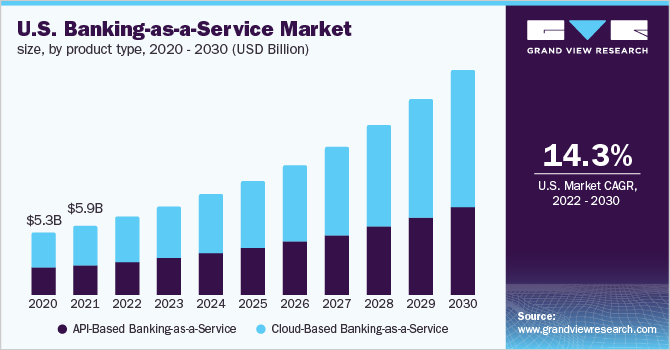
In this comprehensive guide, we’ll provide key information to learn how to start a bank. You’ll learn the different types of banking charters available, capital requirements, regulations, licensing processes, choosing a location, developing products and services, building a team, marketing strategies, and more.
Whether you want to establish a community bank, regional bank, or even an online-only bank, this guide will help. By the end, you’ll have the knowledge and confidence to turn your dream of owning a bank into reality. Let’s start building!
1. Conduct Bank Market Research
Market research is essential to open your own bank. It offers insight into important data about other financial institutions, popular banking services like checking and savings accounts, risk manager infrastructure, and the federal reserve.

Some details you might learn through market research include:
- Modern banking practices: Digital banks now compete for digitally-savvy consumers. This presents an opportunity for new entrants with slick mobile apps, innovative features, and excellent user experience. Incumbents must digitize to retain customers.
- Untraditional banking: Another growth area is serving the underbanked, lower-income consumers often denied access to traditional financial services. New players like Chime prosper through broader inclusion.
- Business banking: The pandemic propelled digitization among small and midsize enterprises (SMEs). They now expect seamless digital services and hyper-personalization once limited to consumers.
- Geographic expansion: Geographic expansion also offers potential, especially in developing markets undergoing rapid modernization. Asia Pacific in particular will drive growth, with over 70% of global banking revenue coming from the region by 2026.
To capitalize on these trends, focus on mobile-first platforms, data-driven personalization, and frictionless digital banking. Market research helps further develop a strong business plan to serve your bank customers.
2. Analyze the Competition
Understanding the competitive landscape is crucial when starting a bank. Begin by identifying direct competitors, the largest national and regional banks operating in your geographic area. Analyze their branch locations, service offerings, fees, rates, and target customers.

Some ways to get to know the financial services industry competition in one banking and personal financial services include:
- For brick-and-mortar banks, visit nearby branches in person. Evaluate their layout, in-branch technology, staffing, and customer service experience.
- Identify potential advantages your bank could offer. Also, consider indirect competitors like credit unions and digital banks competing for customers.
- Evaluate competitors’ digital presence and features.
- Review their website design and mobile apps in app stores, comparing ease of use, functionality, and ratings.
- Sign up for startup bank accounts to test their account opening process and everyday banking experience.
- Look for pain points and unmet needs your bank could address, such as mobile banking, online banking, and other target market requirements.
- Analyze competitors’ social media presence and marketing.
- Follow their pages to see engagement levels, special offers, and events that attract customers.
- Search brand hashtags to find feedback and complaints you can learn from.
- Marketing spend data from similar web provides benchmarking.
By benchmarking competitors across all channels, you gain invaluable insight into customer preferences, pain points, and market white space. Use this analysis to differentiate your bank’s value proposition, location/geographic strategy, products, and digital presence.
3. Costs to Start a Bank Business
Starting an in-person or online banking business takes money. There are startup and ongoing costs you’ll encounter as bank startup entrepreneurs.
Start-up Costs
Starting a new bank involves substantial upfront investment. Before even opening for business, expect considerable costs for licensing, legal fees, technology, hiring, facilities, and more.
- Licensing and Legal – Just obtaining a bank charter can cost $2 million or more in legal fees, processing fees, and state requirements. Ongoing legal assistance for compliance may require an additional $200k+ annually.
- Technology – Core banking software, security systems, and digital platforms require an initial outlay of at least $5 million. Some turnkey solutions like Alkami offer SaaS pricing from $4000/month. Q2 charges enterprise pricing on a custom quote basis. Ongoing tech maintenance and support add another $500k+ per year.
- Staff – Expect initial hiring costs for executive and key support roles 6-12 months pre-launch. With competitive fintech salaries, budget $2 to $3 million in first-year compensation to build a lean team.
- Facilities – Minimum 5,000 sq. ft. for back office and customer banking space can run $30/sq.ft initially to buy/build and $5/sq.ft for annual lease in suburban locations.
- Initial Marketing – Pre-launch marketing including digital channels, print/radio ads, and launch events requires at least a $500k budget.
- Capital Requirements – Regulators require at least $20-30 million in capital reserves upfront, potentially millions more to fund early operations before securing deposits.
- Other expenses – Budget for utilities, insurance, office supplies, printers, security systems, and other basic costs of operation amounting to around $500k first year.
In total, expect start-up costs to reach $50 million or more before opening your doors.
Ongoing Costs
- Staff – Assuming a team of 25 by year 2, payroll will exceed $5 million including executive salaries and employee benefits.
- Facilities – If leasing branches, commercial space runs $25-50/sq.ft in most markets. With 5 locations budget of over $500k annually.
- IT – Maintaining digital infrastructure, security, and software requires an IT budget of $1-2 million annually.
- Marketing – Ongoing promotion costs at least $5 million per year through digital, print, and event marketing.
- Legal/Compliance – Regulatory needs and legal support requires $500k+ per year minimum.
- Customer Acquisition – In fintech, the cost to acquire a customer now exceeds $300 per account on average. With a goal of 20,000+ new accounts in year 1, budget upwards of $6 million.
- Interest Costs – Providing competitive deposit rates and lending capital has high funding costs, especially with ongoing rate hikes. Budget $3-4 million for interest expenses.
- Other – Additional budget for utilities, capital expenditures, insurance, supplies, travel, and other costs of at least $1 million annually.
While exact costs vary by location, regulators, and business model, most new banks should be prepared to invest over $50 million pre-launch and an additional $25 million in year 1 operations before becoming profitable.
4. Form a Legal Business Entity
When launching a new bank, the legal structure you choose determines taxes, liability, and ease of operation.
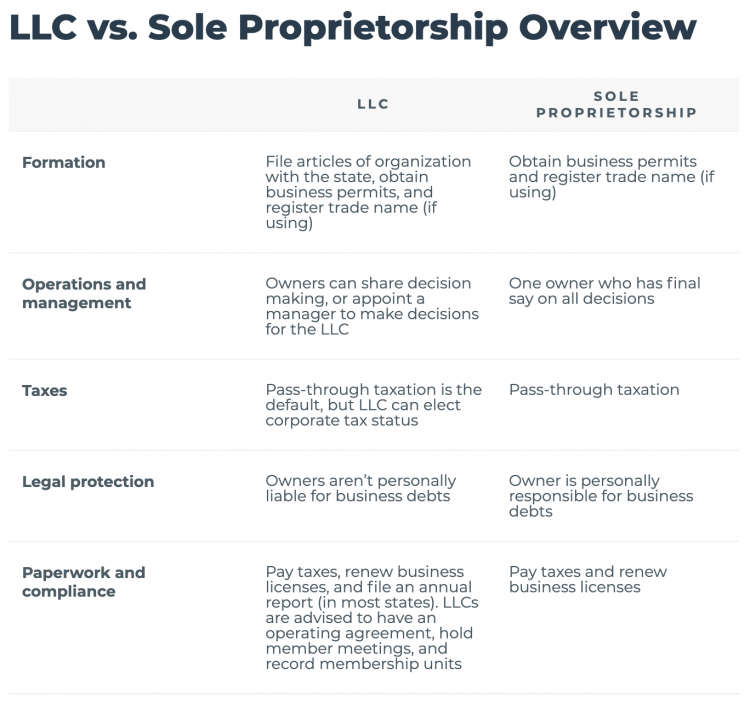
Consider these options:
Sole Proprietorship
A sole proprietorship is the simplest structure – you alone own and operate the business. However major risks exist. As a sole proprietor, you are personally liable for all debts and legal actions against the bank. Your assets can be seized to satisfy business obligations. This unlimited liability makes a sole proprietorship ill-advised for a bank.
Partnership
Forming a general partnership shares liability risks among partners. However, each partner can still be held personally responsible for the activities of the other partners. One partner’s negligence could bankrupt you all. Partnerships also lack continuity – the business must be dissolved if a partner departs.
Limited Liability Company (LLC)
A better option is forming a limited liability company (LLC). This protects your assets from business liabilities and debts. Only assets invested in the LLC are at risk. An LLC also allows tax flexibility – you can choose to be taxed as a sole proprietorship, partnership, or corporation. Simple to establish with minimal ongoing paperwork, an LLC provides legal protections with less administrative burden than a corporation.
Corporation
Forming a corporation or S-corp establishes a separate legal entity that can offer liability protection. However significant legal compliance is required for corporations. You must hold shareholder meetings, keep corporate minutes, and elect directors and officers. Administrative complexity makes a corporation unsuitable for a new bank’s early days. Converting to a corporation later on as the bank grows can make sense.
5. Register Your Business For Taxes
Before opening your bank’s doors, you must obtain an Employer Identification Number or EIN from the IRS. This unique identifier is like a social security number for your business. It’s required to open business bank accounts, apply for licenses and permits, hire employees, and file taxes.
As a new bank, you must have an EIN even if you won’t initially have employees. It’s the key to interacting with regulators, vendors, and customers as an official business. Fortunately obtaining an EIN is fast and free through the IRS website .
To apply online, first review the requirements and gather any information needed. Generally, you’ll need basic information like name, address, ownership details, and reason for applying.
Next, navigate to the EIN Assistant and follow the steps. You’ll provide info, verify your identity, and then get an EIN immediately upon submitting the form.
The entire process typically takes less than 15 minutes. Once you have the EIN, keep it secured along with any IRS correspondence. This number unlocks access to business services you’ll need to operate a bank.
Additionally, register with your state revenue agency for any required sales tax permits and business licenses. Costs vary by location and business activities. Proper licensing prevents issues in collecting sales tax or dealing with state regulators.
6. Setup Your Accounting
Maintaining accurate financial records is crucial for any bank, given the highly regulated nature of the industry. Investing in the right accounting tools and expertise early on saves headaches down the road.
Open a Business Bank Account
Start by establishing dedicated business banking and credit accounts, separate from personal finances. This simplifies record keeping and helps avoid piercing the corporate veil if the business is sued. Apply for company accounts once you have registered your EIN and business legal structure.
Accounting Software
Leverage cloud accounting software like QuickBooks to automatically track income, expenses, account balances, and taxes. QuickBooks sync with bank accounts and credit cards, code transactions, and generate financial statements. This automation provides real-time visibility into the health of your business. Estimated cost is $10-$50 per month.
Hire an Accountant
It’s smart to also partner with an accountant to ensure tax compliance and accurate reporting given the financial stakes. A certified accountant offers services like:
- Bookkeeping – Recording transactions, reconciling accounts
- Cash flow analysis – Monitoring income and outlays
- Tax preparation – Filing quarterly/annual state and federal taxes
- Audit support – Assisting with documentation if audited
Expect to invest at least $1,000 annually for an accountant on retainer for consultation and tax filing. More comprehensive services like monthly bookkeeping range from $2,000-$5,000 per year. But this expertise saves money in the long run by avoiding tax penalties or legal issues.
Apply for a Business Credit Card
Applying for business credit cards also builds your bank’s credit profile and provides flexibility. Issuers weigh factors like revenues, time in business, and personal credit scores to determine credit limits. New businesses can often qualify for $10,000 in initial business credit.
7. Obtain Licenses and Permits
Before welcoming your first customers, every new bank must ensure they have obtained the required permits and licenses. Federal license requirements are available through the U.S. Small Business Administration . The SBA also has local regulations listed through its local search tool.
- Bank charter – This authorization from state or federal regulators is essential to operating legally as a bank. The Office of the Comptroller of the Currency oversees national bank chartering. Each state also has its own banking/financial regulators to apply with for state-chartered banks.
- Sales tax permit – While financial services are not subject to sales tax, you still must register with your state’s taxing authority for a sales permit number. This allows you to purchase tax-exempt items for resale and avoid tax issues.
- Local business banking license – Most cities and counties require a general business license for operating within their jurisdiction. Fees are generally modest. Check each location where your bank has a physical presence.
In addition to licenses, banks must comply with extensive federal regulations including:
- Bank Secrecy Act – Requires reporting suspicious activity to fight fraud and money laundering. Banks must implement Know Your Customer practices as part of an anti-money laundering program monitored by the Treasury.
- Community Reinvestment Act – Under CRA rules banks must meet the credit needs of low to moderate-income neighborhoods. Performance impacts ratings.
- Truth in Lending Act – Banks must fully disclose interest rates and terms for lending products to consumers in a standardized way.
- Fair lending – Banks cannot discriminate on unlawful biases in lending and must ensure equal access to credit.
Staying current on federal and state banking compliance takes dedicated in-house legal resources and/or consultancy partnerships. But meeting these obligations keeps your bank in regulators’ good graces as you build community trust. Don’t open those doors until licensing and compliance are secured.
This sentiment is the same for any sort of business in the banking industry, including starting an ATM business or even a Bitcoin ATM business . You’ll have to take great care making sure you fulfill all of the requirements and pass all the regulations with no issues.
8. Get Business Insurance
Operating a bank carries significant risks that make business insurance essential from day one. Lacking adequate coverage opens the door to potentially catastrophic liabilities. Consider these scenarios:
- A customer slips and falls in a branch, suffering serious injuries. Without liability insurance, their lawsuit could force the bank into bankruptcy.
- A cyber attack exposes thousands of customers’ data. The costs of breach notification, credit monitoring services, and regulatory fines could run into the millions without cyber insurance.
- A natural disaster damages multiple branches. Rebuilding and replacing equipment without insurance could require expensive loans or investors.
Policies like General Liability, Directors and Officers Liability, and Cyber and Property Insurance protect against these threats. Work with a commercial insurance broker to secure customized policies that fit your business model and geographic footprint.
The broker will guide you through the application process:
- Determine needed coverage types and limits based on operations. Requirements depend on services, branch locations, customers, and more.
- Provide details on operations, controls, and risk management to insurers. Stronger controls mean lower premiums.
- Select carrier(s) and undergo underwriting. Insurers will assess risks through documentation review, site visits, and interviews.
- Negotiate tailored policies meeting your needs and budget. Don’t skimp on coverage limits despite high costs.
- Pay premiums and complete any final requirements to bind policies.
- Review policies closely and report any changes that could impact coverage.
While the broker facilitates applications, you must provide thorough disclosure. Hiding details or risks could allow insurers to deny claims down the road. Be transparent to lock in truly comprehensive coverage.
9. Create an Office Space
Securing office space is an important first step when launching a new bank. The right facilities provide room to conduct essential back-office operations and host customers in a professional environment.
Home Office
For the first months, a home office can provide a cost-effective option if allowed by local zoning laws. This supports basic startup needs like paperwork, licensing, hiring, and systems setup without major expense. However, home offices lack the image and amenities needed for the long term.
Retail Office
For banks with extensive branch networks, opening retail locations in the community is standard. High foot traffic spaces project stability and convenience when courting customers. But for digital banks or those starting small, retail branches can be cost-prohibitive at first.
Coworking Office
A flexible coworking space like WeWork bridges the gap between home office and traditional commercial real estate. Coworking offers configurable offices, meeting rooms, and shared amenities without large upfront costs. All-inclusive monthly memberships start at around $300 per month per desk. This grants flexibility to test locations and expand on demand.
Commercial Office
Eventually, most banks require full-scale corporate offices and back office buildings for security, capacity, and stability needs. Expect to invest millions in commercial space leases or property long term. But coworking spaces help fledgling institutions project professionalism without the major capital outlay during launch.
10. Source Your Equipment
Launching a bank requires considerable investment in equipment even before opening the doors. From office furniture to security systems, here are some options for acquiring the necessary materials:
For the latest technology and custom configurations, buying new Equipment is ideal. Vendors like Hamilton offer comprehensive lines of lobby furniture, security tools like vaults/alarms, and tech-like interactive kiosks. Expect premium cost, budgets into the millions are common for outfitting all facilities.
Buying Used
Gently used office furniture, computers, and other equipment offer major savings over new ones. Check used office liquidators, auctions, and commercial brokers. With careful inspection, used can provide quality at 50% or more off retail. Consider used especially for standard items like desks, chairs, and shelves.
Equipment rental through vendors makes more sense for certain short-term or infrequent needs. For example, renting currency counters temporarily during launch or for special events vs. buying outright. Rental costs a fraction of the purchase price. Useful for equipment needed only occasionally.
Long-term equipment leases allow spreading costs over time rather than one-time capital purchases. For essentials like photocopiers, servers, and phone systems, leasing simplifies upgrading later. Typical leases run 3-5 years. Watch for high interest rates and early termination fees, however.
Online Marketplaces
Sites like Craigslist and Facebook Marketplace are great resources for deals on used office and banking equipment from local sellers. Search frequently for desks, safes, technology, and more. Meet to inspect items before purchasing.
11. Establish Your Brand Assets
Developing a strong brand identity is key for any new bank seeking to attract customers and stand out. An intentional approach to your branding conveys professionalism and builds recognition.
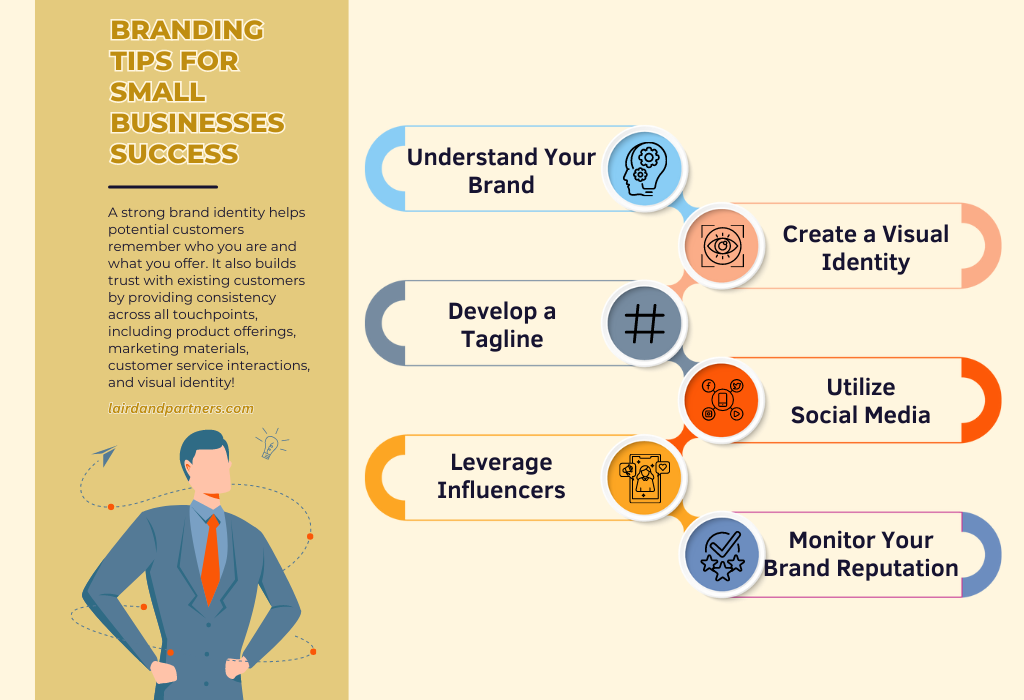
Get a Business Phone Number
Start with securing a dedicated business phone line using a service like RingCentral . Choose a local number customers can call with questions and concerns. A proper business line projects legitimacy and keeps business separate from personal calls.
Design a Logo
Work with a designer to create a polished logo that encapsulates your brand. Consider an abstract mark, letterform, or illustrative logo. Looka’s AI logos provide fast and affordable options starting under $50. Optimize the logo for both digital and print use.
With a logo established, develop complementary brand assets including:
- Color palette – 2-3 brand colors for visual cohesion
- Typography – Fonts matching your style
- Graphic elements – Icons, imagery reinforcing branding
Maintain this consistent look across all customer touchpoints – online, branches, marketing materials, and more. Recognition depends on a unified visual identity.
Print Business Cards
Order professionally printed business cards and signage from Vistaprint . Business cards enable quick sharing of contact information with prospects when networking. Branded apparel like polos and hats visibly display your brand at community events.
Buy a Domain Name
Before marketing begins, purchase your domain name through a registrar like Namecheap . Choose a short, memorable .com address matching your brand name when available. Redirect similar domains to strengthen your online presence.
Design a Website
With a domain secured, build out an informational website via a DIY site builder like Wix or by hiring a web developer on Fiverr . Your site should communicate your value proposition, services, rates, and more while reflecting brand visuals. This digital presence establishes credibility and trust with site visitors.
12. Join Associations and Groups
Joining local banking and business associations provides invaluable connections when starting a new bank. Surround yourself with fellow professionals who can share hard-won experience and industry insights.
Local Banking Associations
Most states have an affiliation of community banks and banker’s associations. For example, the Florida Bankers Association . Membership grants access to events, advocacy, and resources tailored to local banking needs.
Your local Chamber organizes networking events, promotes business interests, and provides valuable startup guidance. Connect with fellow entrepreneurs across industries for cross-promotion opportunities.
Local Meetups
Beyond official associations, attending local banking meetups and tradeshows facilitates networking with peers. Meetup event listings help you find upcoming gatherings. In-person forums foster relationships with potential mentors, partners, and even customers.
Facebook Groups
Online communities further enable connecting with the broader banking ecosystem. For example:
- Banking & Bankers – 98.9k member FB group for bankers worldwide to discuss trends.
- Finance Professionals – 5k member community focused on advancing women in finance.
- BANKER’S GROUP – 44k members interested in fintech and digital transformation.
Embedding yourself locally while also plugging into national groups provides support at each stage of the journey. Learning from fellow bankers helps avoid pitfalls and identify growth opportunities. Surround yourself with the tribe.
13. How to Market a Bank Business
Marketing is crucial for getting the word out and attracting customers as a new bank. Leverage both digital and traditional techniques to build awareness and drive growth.
Tap Into Your Network
Existing connections provide the most fertile ground for referrals, especially early on. Offer incentives for customers to refer friends, like cash bonuses or fee waivers. Nothing fuels growth like word-of-mouth from satisfied members.
Digital Marketing
Online, focus on discoverability and engagement:
- Search Engine Optimization – Optimize website copy, metadata, and backlinks to rank highly for local searches like “bank [city]”. Most prospects search online first.
- Google/Facebook Ads – Targeted local ads raise awareness and drive site traffic to convert visitors into customers.
- Email Marketing – Send emails with personalized offers to website subscribers. Nurture interest and maintain relationships.
- Social Media – Post locally relevant content and specials on platforms like Facebook and Instagram. Build community through engagement.
- YouTube – Share videos on topics like how to open an account. Educational content brings in search traffic.
- Blogging – Publish articles on money management, small business tips, and more to attract search traffic.
Traditional Marketing
Traditional techniques also help expand reach:
- Direct Mailers – Promotional mailers to local homes and businesses make an impression on recipients. Best for grand openings or new location launches.
- Local Events – Sponsoring local races, fairs, and community events raises brand visibility. Have a booth to collect leads.
- Signage – Digital billboards, posters, and other outdoor signage target foot and vehicle traffic. Useful for branch locations.
- Radio – Local radio ads play well with older demographics who still rely on radio. Branding-focused messages work best.
- Print Ads – Newspaper and local magazine ads reach engaged readers. Limit given declining readership.
While digital marketing delivers better targeting and metrics, traditional options help round out promotional efforts with localized awareness building. Evaluate opportunities across both as you get the word out.
14. Focus on the Customer
Providing an exceptional customer experience is crucial for any bank seeking growth and loyalty. In a commoditized industry, service stands out.
- Make account opening and onboarding smooth and personalized. Greet new customers by name and guide them through each step. Follow up after signup to ensure complete satisfaction.
- When issues inevitably occur, resolve problems promptly, politely, and fairly. Empower staff to provide refunds, waivers, or other remedies when appropriate.
- Surprise and delight with small touches like follow-up handwritten notes, personalized rewards, or birthday calls. These reinforce that each customer matters.
- Equip staff to handle complaints with grace. A polite, helpful response transforms frustrations into renewed faith in your bank.
- Implement 24/7 call, chat, and email support with minimal hold times. Make it easy to get assistance whenever needed.
- Follow up with VoC surveys to monitor satisfaction and improve. Solicit honest feedback regularly.
Make customer service a true competitive advantage. Hire for empathy. Train for problem resolution. Empower staff to delight. When you exceed expectations consistently, customers become your best promoters.
You Might Also Like
October 29, 2023
0 comments
How to Start a Bitcoin ATM Business in 14 Steps (In-Depth Guide)
The global crypto ATM industry hit a $71.9 million evaluation in 2021 and is ...
How to Start an ATM Business in 14 Steps (In-Depth Guide)
The ATM industry is expanding at a rapid rate across the world. As of ...
September 23, 2023
The banking industry is growing and evolving in the United States. The current compound ...
Check Out Our Latest Articles
How to start a dog clothing business in 14 steps (in-depth guide), how to start a vintage clothing business in 14 steps (in-depth guide), how to start a bamboo clothing business in 14 steps (in-depth guide), how to start a garage cleaning business in 14 steps (in-depth guide).

IMAGES
VIDEO
COMMENTS
Learn how to create a winning business plan to launch your bank in 2024. This guide covers key bank business plan sections along with a template and checklist
To create an effective business plan, you must first understand the components essential to its success. This article provides an overview of the key elements that every bank business owner should include in their business plan. Download the Ultimate Business Plan Template.
Navigate the complexities of starting a bank, from securing capital to meeting regulatory requirements and delivering trusted financial services.
Step 1: Know The Banking Industry. Step 2: Write a Business Plan. Step 3: Raise Capital. Step 4: Get a Bank Charter. Step 5: Apply for FDIC Approval. Step 6: Apply for Other Necessary Permits. Step 7: Get Customers. Conclusion.
If you want to start a bank or expand your current one, you need a business plan. The guide below details the necessary information for how to write each essential component of your bank business plan.
In this comprehensive guide, we’ll provide key information to learn how to start a bank. You’ll learn the different types of banking charters available, capital requirements, regulations, licensing processes, choosing a location, developing products and services, building a team, marketing strategies, and more.